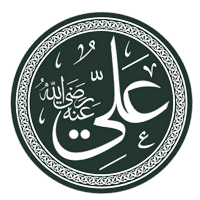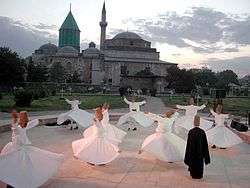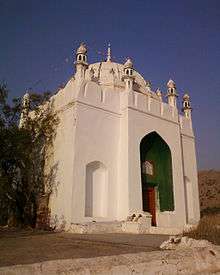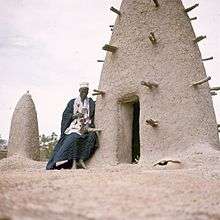Sufism
Sufism or Taṣawwuf[1] (Arabic: التصوف) is defined as the inner mystical dimension of Islam. Practitioners of Sufism, referred to as Sufis (ṣūfī) (/ˈsuːfi/; صُوفِيّ), often belong to different ṭuruq or "orders"—congregations formed around a grand master referred to as a mawla who traces a direct chain of teachers back to the Islamic prophet, Muhammad.[2] These orders meet for spiritual sessions (majalis) in meeting places known as zawiyas, khanqahs, or tekke.[3] Sufis strive for ihsan (perfection of worship) as detailed in a hadith: "Ihsan is to worship Allah as if you see Him; if you can't see Him, surely He sees you."[4] Rumi stated: "The Sufi is hanging on to Muhammad, like Abu Bakr."[5] Sufis regard Muhammad as al-Insān al-Kāmil, the primary perfect man who exemplifies the morality of God.[6] Sufis regard Muhammad as their leader and prime spiritual guide.
All Sufi orders trace many of their original precepts from Muhammad through his cousin and son-in-law Ali with the notable exception of the Naqshbandi, who claim to trace their origins from Muhammad through the first Rashid Caliph, Abu Bakr.[7] Sufi orders largely follow one of the four madhhabs (jurisprudent schools of thought) of Sunni Islam and maintain a Sunni aqidah (creed).[8]
Classical Sufis were characterized by their asceticism, especially by their attachment to dhikr, the practice of repeating the names of God, often performed after prayers.[9] Sufism gained adherents among a number of Muslims as a reaction against the worldliness of the early Umayyad Caliphate (661–750).[10] Sufis have spanned several continents and cultures over a millennium, originally expressing their beliefs in Arabic before spreading into Persian, Turkish, and Urdu among dozens of other languages.[11] According to William Chittick, "In a broad sense, Sufism can be described as the interiorization, and intensification of Islamic faith and practice."[12]
| Part of a series on |
| Islam |
|---|
 |
|
Related topics |
|
Terminology
The term Sufism came into being, not by Islamic texts or Sufis themselves but by British Orientalists who wanted to create an artificial divide between what they found attractive in Islamic civilization (i.e. Islamic Spirituality) and the negative stereotypes that were present in Britain about Islam.[13] These British orientalists, therefore, fabricated a divide that was previously non-existent.[13] The term Sufism has, however, persisted especially in the Western world ever since.
Historically, Muslims have used the Arabic word taṣawwuf to identify the practice of Sufis.[1] Mainstream scholars of Islam define Tasawwuf or Sufism as the name for the inner or esoteric dimension of Islam[14] which is supported and complemented by outward or exoteric practices of Islam, such as Sharia.[15] In this view, "it is absolutely necessary to be a Muslim" to be a true Sufi, because Sufism's "methods are inoperative without" Muslim "affiliation".[16][17] However, Islamic scholars themselves are not by any means in agreement about the meaning of the word "sufi".[18]
Sufis themselves claim that Tasawwuf is an aspect of Islam similar to Sharia,[1] inseparable from Islam and an integral part of Islamic belief and practice.[19] Classical Sufi scholars have defined Tasawwuf as "a science whose objective is the reparation of the heart and turning it away from all else but God".[20] Traditional Sufis such as Bayazid Bastami, Rumi, Haji Bektash Veli, Junayd of Baghdad, and Al-Ghazali, define Sufism as purely based upon the tenets of Islam and the teachings of Muhammad.[18][21][22][23]
Etymology
Sufi
Two origins of the word sufi have been suggested. Commonly, the lexical root of the word is traced to ṣafā (صفاء), which in Arabic means "purity". Another origin is ṣūf (صُوف), "wool" in Arabic, referring to the simple cloaks the early Muslim ascetics wore. The two were combined by the Sufi al-Rudhabari, who said, "The Sufi is the one who wears wool on top of purity".[24][25] Scholars generally agree that ṣūf or "wool" is probably the root word of "Sufi." This term was given to them because they wore woollen garments. The term "labis'al-suf" meant 'he clad himself in wool' and applied to a person who renounced the world and became an ascetic.(Chopra)
Others have suggested that the word comes from the term ahl aṣ-ṣuffah ("the people of the bench"), who were a group of impoverished companions of Muhammad who held regular gatherings of dhikr. These men and women who sat at al-Masjid an-Nabawi are considered by some to be the first Sufis.[26][27] Al-Qushayri and Ibn Khaldun both rejected all possibilities other than ṣūf on linguistic grounds.[28]
History
Origins
Sufi orders are based on the bayah (pledge of allegiance) that was given to the Prophet Muhammad by his Sahaba. By pledging allegiance to the Prophet Muhammad, the Sahaba had committed themselves to the service of God. According to Islamic belief, by pledging allegiance to Prophet Muhammad, the Sahaba have pledged allegiance to God.[30][31]
| “ | Verily, those who give Bai'âh (pledge) to you (O Muhammad SAW) they are giving Bai'âh (pledge) to Allâh. The Hand of Allâh is over their hands. Then whosoever breaks his pledge, breaks it only to his own harm, and whosoever fulfils what he has covenanted with Allâh, He will bestow on him a great reward. - [Translation of Quran, 48:10] | ” |
Sufis believe that by giving bayah (pledging allegiance) to a legitimate Sufi shaykh, one is pledging allegiance to the Prophet Muhammad and therefore a spiritual connection between the seeker and the Prophet Muhammad is established. It is through the Prophet Muhammad that Sufis aim to learn about, understand and connect with God. Ali is regarded as one of the major figures amongst the Sahaba who have directly pledged allegiance to the Prophet Muhammad and Sufis maintain that through Ali, knowledge about the Prophet Muhammad and a connection with the Prophet Muhammad may be attained. Such a concept may be understood by the hadith, which Sufis regard to be authentic, in which Prophet Muhammad said, "I am the city of knowledge and Ali is its gate".[32] Eminent Sufis such as Ali Hujwiri refer to Ali as having a very high ranking in Tasawwuf. Furthermore, Junayd of Baghdad regarded Ali as sheikh of the principals and practices of Tasawwuf.[29]
Practitioners of Sufism hold that in its early stages of development Sufism effectively referred to nothing more than the internalization of Islam.[33] According to one perspective, it is directly from the Qur'an, constantly recited, meditated, and experienced, that Sufism proceeded, in its origin and its development.[34] Others have held that Sufism is the strict emulation of the way of Muhammad, through which the heart's connection to the Divine is strengthened.[35]
Modern academics and scholars have rejected early orientalist theories asserting a non-Islamic origin of Sufism,[36] The consensus is that it emerged in Western Asia. Many have asserted Sufism to be unique within the confines of the Islamic religion and contend that Sufism developed from people like Bayazid Bastami, who, in his utmost reverence to the sunnah, refused to eat a watermelon because he did not find any proof that Muhammad ever ate it.[18][37] According to the late medieval mystic Jami, Abd-Allah ibn Muhammad ibn al-Hanafiyyah (died c. 716) was the first person to be called a "Sufi".[28]
Important contributions in writing are attributed to Uwais al-Qarani, Hasan of Basra, Harith al-Muhasibi and Said ibn al-Musayyib. Ruwaym, from the second generation of Sufis in Baghdad, was also an influential early figure,[38][39] as was Junayd of Baghdad; a number of early practitioners of Sufism were disciples of one of the two.[40]
Sufism had a long history already before the subsequent institutionalization of Sufi teachings into devotional orders (tarîqât) in the early Middle Ages.[41] The Naqshbandi order is a notable exception to general rule of orders tracing their spiritual lineage through Muhammad's grandsons, as it traces the origin of its teachings from Muhammad to the first Islamic Caliph, Abu Bakr.[7]
Over the years Sufi orders have influenced and have been adopted by various Shi'i movements, especially Isma'ilism, which led to the Safaviyya order's conversion to Shia Islam from Sunni Islam and the spread of Twelverism throughout Iran.[42] Sufi orders include Ba 'Alawiyya, Badawiyya, Bektashi, Burhaniyya, Chishti, Khalwati, Mevlevi, Naqshbandi, Ni'matullāhī, Uwaisi, Qadiriyya, Qalandariyya, Rifa'i, Sarwari Qadiri, Shadhiliyya, Suhrawardiyya, Tijaniyyah, Zinda Shah Madariya, and others.[43]
As an Islamic discipline
Sufism is a mystical-ascetic aspect of Islam. It is not a sect, rather it is considered as the part of Islamic teaching that deals with the purification of the inner self. By focusing on the more spiritual aspects of religion, Sufis strive to obtain direct experience of God by making use of "intuitive and emotional faculties" that one must be trained to use.[44] Tasawwuf is regarded as a science of Islam that has always been an integral part of Orthodox Islam. In his Al-Risala al-safadiyya, Ibn Taymiyya describes the Sufis as those who belong to the path of the Sunna and represent it in their teachings and writings.
Ibn Taymiyya's Sufi inclinations and his reverence for Sufis like 'Abd al-Qadir Gilani can also be seen in his hundred-page commentary on Futuh al-ghayb, covering only five of the seventy-eight sermons of the book, but showing that he considered tasawwuf essential within the life of the Islamic community.
In his commentary, Ibn Taymiyya stresses that the primacy of the Shari`a forms the soundest tradition in tasawwuf, and to argue this point he lists over a dozen early masters, as well as more contemporary shaykhs like his fellow Hanbalis, al-Ansari al-Harawi and `Abd al-Qadir, and the latter's own shaykh, Hammad al-Dabbas:The upright among the followers of the Path—like the majority of the early shaykhs (shuyukh al-salaf) such as Fudayl ibn `Iyad, Ibrahim ibn Adham, Ma`ruf al-Karkhi, al-Sari al-Saqati, al-Junayd ibn Muhammad, and others of the early teachers, as well as Shaykh Abd al-Qadir, Shaykh Hammad, Shaykh Abu al-Bayan and others of the later masters—do not permit the followers of the Sufi path to depart from the divinely legislated command and prohibition
Imam Ghazali narrates in Al-Munqidh min-al-dalal:
The vicissitudes of life, family affairs and financial constraints engulfed my life and deprived me of the congenial solitude. The heavy odds confronted me and provided me with few moments for my pursuits. This state of affairs lasted for ten years but wherever I had some spare and congenial moments I resorted to my intrinsic proclivity. During these turbulent years, numerous astonishing and indescribable secrets of life were unveiled to me. I was convinced that the group of Aulia (holy mystics) is the only truthful group who follow the right path, display best conduct and surpass all sages in their wisdom and insight. They derive all their overt or covert behaviour from the illumining guidance of the holy Prophet, the only guidance worth quest and pursuit.
Formalization of doctrine
Towards the end of the first millennium, a number of manuals began to be written summarizing the doctrines of Sufism and describing some typical Sufi practices. Two of the most famous of these are now available in English translation: the Kashf al-Mahjûb of Ali Hujwiri and the Risâla of Al-Qushayri.[45]
Two of al-Ghazali's greatest treatises are the Revival of Religious Sciences and what he termed "its essence", the Kimiya-yi sa'ādat. He argued that Sufism originated from the Qur'an and thus was compatible with mainstream Islamic thought, and did not in any way contradict Islamic Law—being instead necessary to its complete fulfillment. Ongoing efforts by both traditionally trained Muslim scholars and Western academics are making al-Ghazali's works more widely available in English translation, allowing English-speaking readers to judge for themselves the compatibility of Islamic Law and Sufi doctrine. Several sections of the Revival of Religious Sciences have been published in translation by the Islamic Texts Society.[46] An abridged translation (from an Urdu translation) of The Alchemy of Happiness was published by Claud Field (ISBN 978-0935782288) in 1910. It has been translated in full by Muhammad Asim Bilal (2001).[47]
Growth of influence

The rise of Islamic civilization coincides strongly with the spread of Sufi philosophy in Islam. The spread of Sufism has been considered a definitive factor in the spread of Islam, and in the creation of integrally Islamic cultures, especially in Africa[48] and Asia. The Senussi tribes of Libya and the Sudan are one of the strongest adherents of Sufism. Sufi poets and philosophers such as Khoja Akhmet Yassawi, Rumi, and Attar of Nishapur (c. 1145 – c. 1221) greatly enhanced the spread of Islamic culture in Anatolia, Central Asia, and South Asia.[49][50] Sufism also played a role in creating and propagating the culture of the Ottoman world,[51] and in resisting European imperialism in North Africa and South Asia.[52]
Between the 13th and 16th centuries, Sufism produced a flourishing intellectual culture throughout the Islamic world, a "Golden Age" whose physical artifacts survive. In many places a person or group would endow a waqf to maintain a lodge (known variously as a zawiya, khanqah, or tekke) to provide a gathering place for Sufi adepts, as well as lodging for itinerant seekers of knowledge. The same system of endowments could also pay for a complex of buildings, such as that surrounding the Süleymaniye Mosque in Istanbul, including a lodge for Sufi seekers, a hospice with kitchens where these seekers could serve the poor and/or complete a period of initiation, a library, and other structures. No important domain in the civilization of Islam remained unaffected by Sufism in this period.[53]
Present
Current Sufi orders include Alians, Bektashi Order, Mevlevi Order, Ba 'Alawiyya, Chishti Order, Jerrahi, Naqshbandi, Ni'matullāhī, Qadiriyya, Qalandariyya, Sarwari Qadiriyya, Shadhiliyya, Suhrawardiyya, Ashrafi Family, Saifiah (Naqshbandiah), and Uwaisi.[43] The relationship of Sufi orders to modern societies is usually defined by their relationship to governments.[54]
Turkey and Persia together have been a center for many Sufi lineages and orders. The Bektashi were closely affiliated with the Ottoman Janissaries and is the heart of Turkey's large and mostly liberal Alevi population. It has spread westwards to Cyprus, Greece, Albania, Bulgaria, Republic of Macedonia, Bosnia and Herzegovina, Kosovo, and, more recently, to the United States via Albania.
Sufism is popular in such African countries as Tunisia, Algeria, Morocco, and Senegal, where it is seen as a mystical expression of Islam.[55] Sufism is traditional in Morocco but has seen a growing revival with the renewal of Sufism under contemporary spiritual teachers such as Hamza al Qadiri al Boutchichi. Mbacke suggests that one reason Sufism has taken hold in Senegal is because it can accommodate local beliefs and customs, which tend toward the mystical.[56]
The life of the Algerian Sufi master Abdelkader El Djezairi is instructive in this regard.[57] Notable as well are the lives of Amadou Bamba and El Hadj Umar Tall in West Africa, and Sheikh Mansur and Imam Shamil in the Caucasus. In the twentieth century, some Muslims have called Sufism a superstitious religion that holds back Islamic achievement in the fields of science and technology.[58]
A number of Westerners have embarked with varying degrees of success on the path of Sufism. One of the first to return to Europe as an official representative of a Sufi order, and with the specific purpose to spread Sufism in Western Europe, was the Swedish-born wandering Sufi Ivan Aguéli. René Guénon, the French scholar, became a Sufi in the early twentieth century and was known as Sheikh Abdul Wahid Yahya. His manifold writings defined the practice of Sufism as the essence of Islam but also pointed to the universality of its message. Other spiritualists, such as George Gurdjieff, may or may not conform to the tenets of Sufism as understood by orthodox Muslims.
Other noteworthy Sufi teachers who have been active in the West in recent years include Bawa Muhaiyaddeen, Inayat Khan, Nazim Al-Haqqani, Javad Nurbakhsh, Bulent Rauf, Irina Tweedie, Idries Shah, Muzaffer Ozak, Nahid Angha, and Ali Kianfar.
Currently active Sufi academics and publishers include Llewellyn Vaughan-Lee, Nuh Ha Mim Keller, Abdullah Nooruddeen Durkee, Waheed Ashraf, Omer Tarin, and Timothy Winter.
Aims and objectives
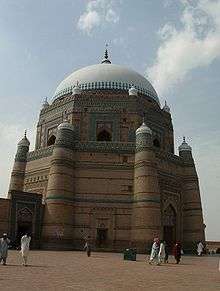
While all Muslims believe that they are on the pathway to Allah and hope to become close to God in Paradise—after death and after the Last Judgment—Sufis also believe that it is possible to draw closer to God and to more fully embrace the divine presence in this life.[59] The chief aim of all Sufis is to seek the pleasing of God by working to restore within themselves the primordial state of fitra,[60] described in the Quran. In this state nothing one does defies God, and all is undertaken with the single motivation of ishq.
To Sufis, the outer law consists of rules pertaining to worship, transactions, marriage, judicial rulings, and criminal law—what is often referred to, broadly, as "qanun". The inner law of Sufism consists of rules about repentance from sin, the purging of contemptible qualities and evil traits of character, and adornment with virtues and good character.[61]
Teachings

To the Sufi, it is the transmission of divine light from the teacher's heart to the heart of the student, rather than worldly knowledge, that allows the adept to progress. They further believe that the teacher should attempt inerrantly to follow the Divine Law.[62]
According to Moojan Momen "one of the most important doctrines of Sufism is the concept of al-Insan al-Kamil "the Perfect Man". This doctrine states that there will always exist upon the earth a "Qutb" (Pole or Axis of the Universe)—a man who is the perfect channel of grace from God to man and in a state of wilayah (sanctity, being under the protection of Allah). The concept of the Sufi Qutb is similar to that of the Shi'i Imam.[63][64] However, this belief puts Sufism in "direct conflict" with Shia Islam, since both the Qutb (who for most Sufi orders is the head of the order) and the Imam fulfill the role of "the purveyor of spiritual guidance and of Allah's grace to mankind". The vow of obedience to the Shaykh or Qutb which is taken by Sufis is considered incompatible with devotion to the Imam".[63]
As a further example, the prospective adherent of the Mevlevi Order would have been ordered to serve in the kitchens of a hospice for the poor for 1001 days prior to being accepted for spiritual instruction, and a further 1,001 days in solitary retreat as a precondition of completing that instruction.[65]
Some teachers, especially when addressing more general audiences, or mixed groups of Muslims and non-Muslims, make extensive use of parable, allegory, and metaphor.[66] Although approaches to teaching vary among different Sufi orders, Sufism as a whole is primarily concerned with direct personal experience, and as such has sometimes been compared to other, non-Islamic forms of mysticism (e.g., as in the books of Hossein Nasr).
Many Sufi believe that to reach the highest levels of success in Sufism typically requires that the disciple live with and serve the teacher for a long period of time. An example is the folk story about Baha-ud-Din Naqshband Bukhari, who gave his name to the Naqshbandi Order. He is believed to have served his first teacher, Sayyid Muhammad Baba As-Samasi, for 20 years, until as-Samasi died. He is said to then have served several other teachers for lengthy periods of time. He is said to have helped the poorer members of the community for many years and after this concluded his teacher directed him to care for animals cleaning their wounds, and assisting them.[67]
Muhammad
| “ | His [Muhammad's] aspiration preceded all other aspirations, his existence preceded nothingness, and his name preceded the Pen, because he existed before all peoples. There is not in the horizons, beyond the horizons or below the horizons, anyone more elegant, more noble, more knowing, more just, more fearsome, or more compassionate, than the subject of this tale. He is the leader of created beings, the one "whose name is glorious Ahmad"[Quran 61:6]. | ” |
Devotion to Muhammad is an exceptionally strong practice within Sufism.[69] Sufis have historically revered Muhammad as the prime personality of spiritual greatness. The Sufi poet Saadi Shirazi stated, "He who chooses a path contrary to that of the prophet [Muhammad], shall never reach the destination. O Saadi, do not think that one can treat that way of purity except in the wake of the chosen one [Muhammad]."[70] Rumi attributes his self-control and abstinence from worldly desires as qualities attained by him through the guidance of Muhammad. Rumi states, "I 'sewed' my two eyes shut from [desires for] this world and the next – this I learned from Muhammad."[71] Ibn Arabi regards Muhammad as the greatest man and states, "Muhammad's wisdom is uniqueness (fardiya) because he is the most perfect existent creature of this human species. For this reason, the command began with him and was sealed with him. He was a Prophet while Adam was between water and clay, and his elemental structure is the Seal of the Prophets."[72] Attar of Nishapur claimed that he praised Muhammad in such a manner that was not done before by any poet, in his book the Ilahi-nama.[73] Fariduddin Attar stated, "Muhammad is the exemplar to both worlds, the guide of the descendants of Adam. He is the sun of creation, the moon of the celestial spheres, the all-seeing eye...The seven heavens and the eight gardens of paradise were created for him, he is both the eye and the light in the light of our eyes."[74] Sufis have historically stressed the importance of Muhammad's perfection and his ability to intercede. The persona of Muhammad has historically been and remains an integral and critical aspect of Sufi belief and practice.[69] Bayazid Bastami is recorded to have been so devoted to the sunnah of Muhammad that he refused to eat a watermelon due to the fact that he could not establish that Muhammad ever ate one.[75]
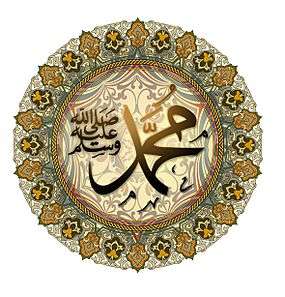
In the 13th century, a Sufi poet from Egypt, Al-Busiri, wrote the al-Kawākib ad-Durrīya fī Madḥ Khayr al-Barīya (The Celestial Lights in Praise of the Best of Creation) commonly referred to as Qaṣīdat al-Burda ("Poem of the Mantle"), in which he extensively praised Muhammad.[76] This poem is still widely recited and sung amongst Sufi groups all over the world.[76]
Sufi beliefs about Muhammad
According to Ibn Arabi, Islam is the best religion because of Muhammad.[6] Ibn Arabi regards that the first entity that was brought into existence is the reality or essence of Muhammad (al-ḥaqīqa al-Muhammadiyya). Ibn Arabi regards Muhammad as the supreme human being and master of all creatures. Muhammad is therefore the primary role-model for human beings to aspire to emulate.[6] Ibn Arabi believes that God's attributes and names are manifested in this world and that the most complete and perfect display of these divine attributes and names are seen in Muhammad.[6] Ibn Arabi believes that one may see God in the mirror of Muhammad, meaning that the divine attributes of God are manifested through Muhammad.[6] Ibn Arabi maintains that Muhammad is the best proof of God and by knowing Muhammad one knows God.[6] Ibn Arabi also maintains that Muhammad is the master of all of humanity in both this world and the afterlife. In this view, Islam is the best religion, because Muhammad is Islam.[6]
Sufis maintain that the Prophet Muhammad is Al-Insān al-Kāmil. Sufis believe that aid and support may be received from Prophet Muhammad, even today. Sufis believe that the Prophet Muhammad listens to them when they call upon him. Sufis strive towards having a relationship with Prophet Muhammad and seeking to see Prophet Muhammad in a dream is a common Sufi practice.
Sufism and Islamic law
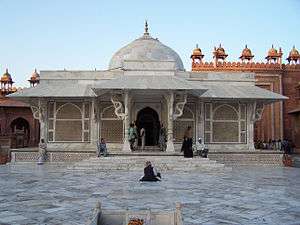
Sufis believe the sharia (exoteric "canon"), tariqa (esoteric "order") and haqiqa ("truth") are mutually interdependent.[77] Sufism leads the adept, called salik or "wayfarer", in his sulûk or "road" through different stations (maqaam) until he reaches his goal, the perfect tawhid, the existential confession that God is One.[78] Ibn Arabi says, "When we see someone in this Community who claims to be able to guide others to God, but is remiss in but one rule of the Sacred Law—even if he manifests miracles that stagger the mind—asserting that his shortcoming is a special dispensation for him, we do not even turn to look at him, for such a person is not a sheikh, nor is he speaking the truth, for no one is entrusted with the secrets of God Most High save one in whom the ordinances of the Sacred Law are preserved. (Jamiʿ karamat al-awliyaʾ)".[79]
The Amman Message, a detailed statement issued by 200 leading Islamic scholars in 2005 in Amman, and adopted by the Islamic world's political and temporal leaderships at the Organisation of the Islamic Conference summit at Mecca in December 2005, and by six other international Islamic scholarly assemblies including the International Islamic Fiqh Academy of Jeddah, in July 2006, specifically recognized the validity of Sufism as a part of Islam—however the definition of Sufism can vary drastically between different traditions (what may be intended is simple tazkiah as opposed to the various manifestations of Sufism around the Islamic world).[80]
Traditional Islamic thought and Sufism
The literature of Sufism emphasizes highly subjective matters that resist outside observation, such as the subtle states of the heart. Often these resist direct reference or description, with the consequence that the authors of various Sufi treatises took recourse to allegorical language. For instance, much Sufi poetry refers to intoxication, which Islam expressly forbids. This usage of indirect language and the existence of interpretations by people who had no training in Islam or Sufism led to doubts being cast over the validity of Sufism as a part of Islam. Also, some groups emerged that considered themselves above the Sharia and discussed Sufism as a method of bypassing the rules of Islam in order to attain salvation directly. This was disapproved of by traditional scholars.
For these and other reasons, the relationship between traditional Islamic scholars and Sufism is complex and a range of scholarly opinion on Sufism in Islam has been the norm. Some scholars, such as Al-Ghazali, helped its propagation while other scholars opposed it. William Chittick explains the position of Sufism and Sufis this way:
In short, Muslim scholars who focused their energies on understanding the normative guidelines for the body came to be known as jurists, and those who held that the most important task was to train the mind in achieving correct understanding came to be divided into three main schools of thought: theology, philosophy, and Sufism. This leaves us with the third domain of human existence, the spirit. Most Muslims who devoted their major efforts to developing the spiritual dimensions of the human person came to be known as Sufis.[18]
Traditional and Neo-Sufi groups

The traditional Sufi orders, which are in majority, emphasize the role of Sufism as a spiritual discipline within Islam. Therefore, the Sharia (traditional Islamic law) and the Sunnah are seen as crucial for any Sufi aspirant. One proof traditional orders assert is that almost all the famous Sufi masters of the past Caliphates were experts in Sharia and were renowned as people with great Iman (faith) and excellent practice. Many were also Qadis (Sharia law judges) in courts. They held that Sufism was never distinct from Islam and to fully comprehend and practice Sufism one must be an observant Muslim.
"Neo-Sufism," "pseudo-Sufism," and "universal Sufism" are terms used to denote forms of Sufism that do not require adherence to Shariah, or the Muslim faith.[81][82] The terms are not always accepted by those it is applied to. For example, the Afghan-Scottish teacher Idries Shah has been described as a neo-Sufi by the Gurdjieffian James Moore.[83] The Sufi Order in the West was founded by Inayat Khan, teaching the essential unity of all faiths, and accepting members of all creeds. Sufism Reoriented is an offshoot of it charted by the syncretistic teacher Meher Baba. The Golden Sufi Center exists in England, Switzerland and the United States. It was founded by Llewellyn Vaughan-Lee to continue the work of his teacher Irina Tweedie, herself a practitioner of both Hinduism and neo-Sufism. Other Western Sufi organisations include the Sufi Foundation of America and the International Association of Sufism.
Western Neo-Sufi practices may differ from traditional forms, for instance having mixed-gender meetings and less emphasis on the Qur'an.
Theoretical perspectives
.jpg)
Traditional Islamic scholars have recognized two major branches within the practice of Sufism, and use this as one key to differentiating among the approaches of different masters and devotional lineages.[84]
On the one hand there is the order from the signs to the Signifier (or from the arts to the Artisan). In this branch, the seeker begins by purifying the lower self of every corrupting influence that stands in the way of recognizing all of creation as the work of God, as God's active Self-disclosure or theophany.[85] This is the way of Imam Al-Ghazali and of the majority of the Sufi orders.
On the other hand, there is the order from the Signifier to His signs, from the Artisan to His works. In this branch the seeker experiences divine attraction (jadhba), and is able to enter the order with a glimpse of its endpoint, of direct apprehension of the Divine Presence towards which all spiritual striving is directed. This does not replace the striving to purify the heart, as in the other branch; it simply stems from a different point of entry into the path. This is the way primarily of the masters of the Naqshbandi and Shadhili orders.[86]
Contemporary scholars may also recognize a third branch, attributed to the late Ottoman scholar Said Nursi and explicated in his vast Qur'an commentary called the Risale-i Nur. This approach entails strict adherence to the way of Muhammad, in the understanding that this wont, or sunnah, proposes a complete devotional spirituality adequate to those without access to a master of the Sufi way.[87]
Contributions to other domains of scholarship
Sufism has contributed significantly to the elaboration of theoretical perspectives in many domains of intellectual endeavor. For instance, the doctrine of "subtle centers" or centers of subtle cognition (known as Lataif-e-sitta) addresses the matter of the awakening of spiritual intuition.[88] In general, these subtle centers or latâ'if are thought of as faculties that are to be purified sequentially in order to bring the seeker's wayfaring to completion. A concise and useful summary of this system from a living exponent of this tradition has been published by Muhammad Emin Er.[84]
Sufi psychology has influenced many areas of thinking both within and outside of Islam, drawing primarily upon three concepts. Ja'far al-Sadiq (both an imam in the Shia tradition and a respected scholar and link in chains of Sufi transmission in all Islamic sects) held that human beings are dominated by a lower self called the nafs (soul), a faculty of spiritual intuition called the qalb (heart), and ruh (spirit). These interact in various ways, producing the spiritual types of the tyrant (dominated by nafs), the person of faith and moderation (dominated by the spiritual heart), and the person lost in love for God (dominated by the ruh).[89]
Of note with regard to the spread of Sufi psychology in the West is Robert Frager, a Sufi teacher authorized in the Khalwati Jerrahi order. Frager was a trained psychologist, born in the United States, who converted to Islam in the course of his practice of Sufism and wrote extensively on Sufism and psychology.[90]
Sufi cosmology and Sufi metaphysics are also noteworthy areas of intellectual accomplishment.
Devotional practices
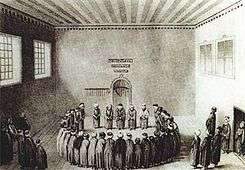
The devotional practices of Sufis vary widely. This is because an acknowledged and authorized master of the Sufi path is in effect a physician of the heart, able to diagnose the seeker's impediments to knowledge and pure intention in serving God, and to prescribe to the seeker a course of treatment appropriate to his or her maladies. The consensus among Sufi scholars is that the seeker cannot self-diagnose, and that it can be extremely harmful to undertake any of these practices alone and without formal authorization.[91]
Prerequisites to practice include rigorous adherence to Islamic norms (ritual prayer in its five prescribed times each day, the fast of Ramadan, and so forth). Additionally, the seeker ought to be firmly grounded in supererogatory practices known from the life of Muhammad (such as the "sunna prayers"). This is in accordance with the words, attributed to God, of the following, a famous Hadith Qudsi:
My servant draws near to Me through nothing I love more than that which I have made obligatory for him. My servant never ceases drawing near to Me through supererogatory works until I love him. Then, when I love him, I am his hearing through which he hears, his sight through which he sees, his hand through which he grasps, and his foot through which he walks.
It is also necessary for the seeker to have a correct creed (Aqidah),[92] and to embrace with certainty its tenets.[93] The seeker must also, of necessity, turn away from sins, love of this world, the love of company and renown, obedience to satanic impulse, and the promptings of the lower self. (The way in which this purification of the heart is achieved is outlined in certain books, but must be prescribed in detail by a Sufi master.) The seeker must also be trained to prevent the corruption of those good deeds which have accrued to his or her credit by overcoming the traps of ostentation, pride, arrogance, envy, and long hopes (meaning the hope for a long life allowing us to mend our ways later, rather than immediately, here and now).
Sufi practices, while attractive to some, are not a means for gaining knowledge. The traditional scholars of Sufism hold it as absolutely axiomatic that knowledge of God is not a psychological state generated through breath control. Thus, practice of "techniques" is not the cause, but instead the occasion for such knowledge to be obtained (if at all), given proper prerequisites and proper guidance by a master of the way. Furthermore, the emphasis on practices may obscure a far more important fact: The seeker is, in a sense, to become a broken person, stripped of all habits through the practice of (in the words of Imam Al-Ghazali) solitude, silence, sleeplessness, and hunger.[94]
Magic may have also been a part of some Sufi practices, notably in India.[95] The practice of magic intensified during the declining years of Sufism in India when the Sufi orders grew steadily in wealth and in political influence while their spirituality gradually declined and they concentrated on saint veneration, miracle working, magic and superstition.
Dhikr

Dhikr is the remembrance of Allah commanded in the Qur'an for all Muslims through a specific devotional act, such as the repetition of divine names, supplications and aphorisms from hadith literature and the Qur'an. More generally, dhikr takes a wide range and various layers of meaning.[96] This includes dhikr as any activity in which the Muslim maintains awareness of Allah. To engage in dhikr is to practice consciousness of the Divine Presence and love, or "to seek a state of godwariness". The Qur'an refers to Muhammad as the very embodiment of dhikr of Allah (65:10–11). Some types of dhikr are prescribed for all Muslims and do not require Sufi initiation or the prescription of a Sufi master because they are deemed to be good for every seeker under every circumstance.[97]
The Dhikr may slightly vary among each order. Some Sufi orders[98] engage in ritualized dhikr ceremonies, or sema. Sema includes various forms of worship such as: recitation, singing (the most well known being the Qawwali music of the Indian subcontinent), instrumental music, dance (most famously the Sufi whirling of the Mevlevi order), incense, meditation, ecstasy, and trance.[99]
Some Sufi orders stress and place extensive reliance upon Dhikr. This practice of Dhikr is called Dhikr-e-Qulb (invocation of Allah within the heartbeats). The basic idea in this practice is to visualize the Allah as having been written on the disciple's heart.[100]
Muraqaba
The practice of muraqaba can be likened to the practices of meditation attested in many faith communities.[101] The word muraqaba is derived from the same root (r-q-b) occurring as one of the 99 Names of God in the Qur'an, al-Raqîb, meaning "the Vigilant" and attested in verse 4:1 of the Qur'an. Through muraqaba, a person watches over or takes care of the spiritual heart, acquires knowledge about it, and becomes attuned to the Divine Presence, which is ever vigilant.
While variation exists, one description of the practice within a Naqshbandi lineage reads as follows:
He is to collect all of his bodily senses in concentration, and to cut himself off from all preoccupation and notions that inflict themselves upon the heart. And thus he is to turn his full consciousness towards God Most High while saying three times: "Ilahî anta maqsûdî wa-ridâka matlûbî—my God, you are my Goal and Your good pleasure is what I seek". Then he brings to his heart the Name of the Essence—Allâh—and as it courses through his heart he remains attentive to its meaning, which is "Essence without likeness". The seeker remains aware that He is Present, Watchful, Encompassing of all, thereby exemplifying the meaning of his saying (may God bless him and grant him peace): "Worship God as though you see Him, for if you do not see Him, He sees you". And likewise the prophetic tradition: "The most favored level of faith is to know that God is witness over you, wherever you may be".[102]
Sufi whirling
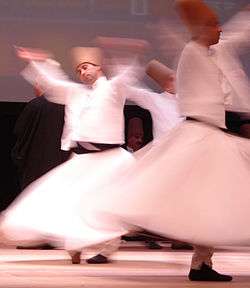
Sufi whirling (or Sufi spinning) is a form of Sama or physically active meditation which originated among Sufis, and which is still practised by the Sufi Dervishes of the Mevlevi order. It is a customary dance performed within the sema, through which dervishes (also called semazens, from Persian سماعزن) aim to reach the source of all perfection, or kemal. This is sought through abandoning one's nafs, egos or personal desires, by listening to the music, focusing on God, and spinning one's body in repetitive circles, which has been seen as a symbolic imitation of planets in the Solar System orbiting the sun.[103] As explained by Sufis:[104]
In the symbolism of the Sema ritual, the semazen's camel's hair hat (sikke) represents the tombstone of the ego; his wide, white skirt (tennure) represents the ego's shroud. By removing his black cloak (hırka), he is spiritually reborn to the truth. At the beginning of the Sema, by holding his arms crosswise, the semazen appears to represent the number one, thus testifying to God's unity. While whirling, his arms are open: his right arm is directed to the sky, ready to receive God's beneficence; his left hand, upon which his eyes are fastened, is turned toward the earth. The semazen conveys God's spiritual gift to those who are witnessing the Sema. Revolving from right to left around the heart, the semazen embraces all humanity with love. The human being has been created with love in order to love. Mevlâna Jalâluddîn Rumi says, "All loves are a bridge to Divine love. Yet, those who have not had a taste of it do not know!"
Visitation
In popular Sufism (i.e., devotional practices that have achieved currency in world cultures through Sufi influence), one common practice is to visit or make pilgrimages to the tombs of saints, great scholars, and righteous people. This is a particularly common practice in South Asia, where famous tombs include those of Afāq Khoja, near Kashgar, in China; Lal Shahbaz Qalander, in Sindh, Ali Hajwari in Lahore Bawaldin Zikrya in Multan Pakistan; Moinuddin Chishti in Ajmer, India; Nizamuddin Auliya in Delhi, India, and Shah Jalal in Sylhet, Bangladesh. Likewise, in Fez, Morocco, a popular destination for such pious visitation is the Zaouia Moulay Idriss II and the yearly visitation to see the current Sheikh of the Qadiri Boutchichi Tariqah, Sheikh Sidi Hamza al Qadiri al Boutchichi to celebrate the Mawlid (which is usually televised on Moroccan National television). The purpose of such visitations is usually two-fold, first and foremost the aim is to receive spiritual guidance and blessings from the Saint who rests in the shrine, which helps the Seeker in his or her own path towards enlightenment. Secondly, the Saint is also approached for intercession in prayers, be it in worldly matters or religious.
Persecution
Persecution of Sufis and Sufism has included destruction of Sufi shrines and mosques, suppression of orders, and discrimination against adherents in a number of Muslim countries. The Turkish Republican state banned all Sufi orders and abolished their institutions in 1925 after Sufis opposed the new secular order. The Iranian Islamic Republic has harassed Shia Sufis, reportedly for their lack of support for the government doctrine of "governance of the jurist" (i.e., that the supreme Shiite jurist should be the nation's political leader). In most other Muslim countries, attacks on Sufis and especially their shrines have come from adherents of puritanical schools of thought who believe that practices such as celebration of the birthdays of Sufi saints, and dhikr ("remembrance" of God) ceremonies are bid‘ah or impure innovation, and polytheistic (Shirk).[105][106][107]
History

In the Safavid dynasty of Iran, "both the wandering dervishes of 'low' Sufism" and "the philosopher-ulama of 'high' Sufism came under relentless pressure" from powerful cleric Muhammad Baqir Majlisi (d1110/1699). Majlisi—"one of the most powerful and influential" Twelver Shiʿi ulama "of all time"—was famous for (among other things), suppression of Sufism, which he and his followers believed paid insufficient attention to Shariah law. Prior to Majlisi's rise, Shiism and Sufism had been "closely linked".[108]
In 1843, the Senussi Sufi were forced to flee Mecca and Medina and head to Sudan and Libya.[10][109]
According to a 2005 article in The Guardian:
Before the first world war there were almost 100,000 disciples of the Mevlevi order throughout the Ottoman empire. But in 1925, as part of his desire to create a modern, western-orientated, secular state, Atatürk banned all the different Sufi orders and closed their tekkes. Pious foundations were suspended and their endowments expropriated; Sufi hospices were closed and their contents seized; all religious titles were abolished and dervish clothes outlawed. [...] In 1937, Atatürk went even further, prohibiting by law any form of traditional music, especially the playing of the ney, the Sufis' reed flute.[110][111]
Current attacks
In recent years, shrines, and sometimes mosques, have been damaged or destroyed in many parts of the Muslim world. Some Sufi adherents have been killed as well. Ali Gomaa, a Sufi scholar and Grand Mufti of al-Azhar University, has criticized the destruction of shrines and public property as unacceptable.[112]
Pakistan
Since March 2005, 209 people have been killed and 560 injured in 29 different terrorist attacks targeting shrines devoted to Sufi saints in Pakistan, according to data compiled by the Center for Islamic Research Collaboration and Learning (CIRCLe, a think-tank based in Rawalpindi).[113] At least as of 2010, the attacks have increased each year. Pro-Sufism Barelvis dominate Pakistan's religious landscape, and are victims of the anti-Sufi campaigns of the Deobandi according to author John R. Schmidt.[114][115] Deobandi and Barelvi are the "two major sub-sects" of Sunni Muslims in South Asia that have clashed—sometimes violently—since the late 1970s in Pakistan.[116] It is not clear whether Sufis are being persecuted by Barelvi or Deobandi state banned militant organizations, since both groups have been accused of anti-Shia terrorism.[113][117][118]
In 2005, militant organizations began attacking "symbols" of the Barelvi community such as mosques, prominent religious leaders, and shrines.[113]
Timeline
- 2005
- 19 March: a suicide bomber kills at least 35 people and injured many more at the shrine of Pir Rakhel Shah in remote village of Fatehpur located in Jhal Magsi District of Balochistan. The dead included Shia and Sunni devotees.[119]
- 27 May: As many as 20 people are killed and 100 injured when a suicide-bomber attacks a gathering at Bari Imam Shrine during the annual festival. The dead were mainly Shia.[120] According to the police members of Sipah-i-Sahaba Pakistan (SSP) and Lashkar-e-Jhangvi (LJ) were involved.[121] Sipah-e-Sahaba Pakistan (SSP), were arrested from Thanda Pani and police seized two hand grenades from their custody.[122][123]
- 2006
- 11 April: A suicide-bomber attacked a celebration of the birthday of Muhammad (Mawlid) in Karachi's Nishtar Park organised by the Barelvi Jamaat Ahle Sunnat. 57 died including almost the entire leadership of the Sunni Tehrik; over 100 were injured.[124] Three people associated with Lashkar-e-Jhangvi were put on trial for the bombing.[125] (see: Nishtar Park bombing)
- 2007
- 18 December: The shrine of Abdul Shakoor Malang Baba is demolished by explosives.[126]
- 2008
- March 3: ten villagers killed in a rocket attack on the 400-year-old shrine of Abu Saeed Baba. Lashkar-e-Islam takes credit.[126]
- 2009
- 17 February: Agha Jee shot and killed in Peshwar, the fourth faith healer killed over several months in Pakistan. Earlier Pir Samiullah was killed in Swat by the Taliban 16 December 2008. His dead body was later exhumed and desecrated. Pir Rafiullah was kidnapped from Nowshera and his beheaded body was found in Matani area of Peshawar. Pir Juma Khan was kidnapped from Dir Lower and his beheaded body was found near Swat.[127] Faith healing is associated with Sufi Islam in Pakistan and suppressing it has been a cause of "extremist" Muslims there.[128]
Pakistani faith healers are known as pirs, a term that applies to the descendants of Sufi Muslim saints. Under Sufism, those descendants are thought to serve as conduits to God. The popularity of pirs as a viable healthcare alternative stems from the fact that, in much of rural Pakistan, clinics don't exist or are dismissed as unreliable. For the urban wealthy, belief in a pir's powers is either something passed down through the generations, or a remedy of last resort, a kind of Pakistani laetrile.[129]
- March 5: The shrine of Rahman Baba, "the most famous Sufi Pashto language poet", razed to the ground by Taliban militants "partly because local women had been visiting the shrine".[126][130]
- 8 March: Attack on shrine of "famous Sufi poet" Rahman Baba(1653–1711) in Peshawar. "The high intensity device almost destroyed the grave of the Rehman Baba and the gates of a mosque, canteen and conference hall situated in the spacious Rehman Baba Complex. Police said the bombers had tied explosives around the pillars of the tombs, to pull down the mausoleum".[131]
- May 8: shrine of Shaykh Omar Baba destroyed.[126][132]
- 12 June: Mufti Sarfraz Ahmed Naeemi killed by suicide bomber in Lahore. A leading Sunni Islamic cleric in Pakistan he was well known for his moderate views and for publicly denouncing the Taliban's beheadings and suicide bombings as "un-Islamic".[133]
- 2010
- 22 June: Taliban militants blow up the Mian Umar Baba shrine in Peshawar. No fatalities reported.[126][134]
- 1 July: Multiple bombings of Data Durbar Complex Sufi shrine, in Lahore, Punjab. Two suicide bombers blew themselves up killing at least 50 people and injuring 200 others.[126]
- 7 October: 10 people killed, 50 injured in a double suicide bombing attack on Abdullah Shah Ghazi shrine in Karachi[135]
- 7 October: The tomb of Baba Fariddudin Ganj Shakkar in Pakpattan is attacked. Six people were killed and 15 others injured.[126]
- 25 October: 6 killed, and at least 12 wounded in an attack on the shrine of 12th-century saint, Baba Farid Ganj Shakar in Pakpattan.[136]
- 14 December: Attack on Ghazi Baba shrine in Peshawar, 3 killed.[137]
- 2011
- 3 February: Remote-controlled device is triggered as food is being distributed among the devotees outside the Baba Haider Saieen shrine in Lahore, Punjab. At least three people were killed and 27 others injured.[126]
- 3 April: Twin suicide attack leaves 42 dead and almost a hundred injured during the annual Urs festival at shrine of 13th century Sufi saint Sakhi Sarwar (a.k.a. Ahmed Sultan) in the Dera Ghazi Khan district of Punjab province. Tehrik-e-Taliban Pakistan (TTP) claims responsibility for the attack.[126][138]
- 2012
- 21 June: Bomb kills three people and injures 31 others at the Pinza Piran shrine in Hazarkhwani in Peshawar. "A police official said the bomb was planted in a donkey-cart that went off in the afternoon when a large number of people were visiting the popular shrine".[139]
- 2016
- 12 November: Bomb kills 52 and injures over a hundred at Shah Noorani, Balochistan[140]
Kashmir Valley
During the rule of Chaks and Shahmiris, the Sufis were given superior positions by the rulers and it was during those times that six orders of Sufism existed which were Qadiria, Sahurwardia, Kibrawiya, Naqashbandia, Noorbakhshia and Rishia, The first five had arrived from Iran and Turkistan and the sixth one was from Kashmir which had all elements present in it due to different religious orders which included Shaivinism, and Hinduism and which ultimately culminated into Islamic Sufism due to the inspiration of Sufis who had arrived here to spread Islam.
Some six places of worship have been either completely or partially burnt in "mysterious fires" in several months leading up to November 2012.[141] The most prominent victim of damage was the Dastageer Sahib Sufi shrine in Srinagar which burned in June 2012, injuring 20.[142] While investigators have so far found no sign of arson, the journalist Amir Rana alleges that the fires have occurred within the context of a surging Salafi movement which, according to Rana, preaches that "Kashmiri tradition of venerating the tombs and relics of saints is outside the pale of Islam".[141]
Somalia
Under the Al-Shabab rule in Somali, Sufi ceremonies were banned[143] and shrines destroyed.[144] As the power of Al-Shabab has waned, however, Sufi ceremonies are said to have "re-emerged".[145] Ahlu Sunna Waljama'a Sufi militants, backed by Ethiopia and the federal government, control parts of central Somalia and some cities in the southern regions of Gedo and Bakool.
Mali
In the ancient city of Timbuktu, sometimes called "the city of 333 saints", UNESCO reports that as many as half of the city's shrines "have been destroyed in a display of fanaticism", as of July 2012. A spokesman for Ansar Dine has stated that "the destruction is a divine order", and that the group had plans to destroy every single Sufi shrine in the city, "without exception".[146] In Gao and Kidal, as well as Timbuktu, Salafi Islamists have destroyed musical instruments and driven musicians (music is not Haraam under Sufi Islam) into "economic exile" away from Mali.[147]
International Criminal Court Chief Prosecutor Fatou Bensouda described the Islamists' actions as a "war crime".[148][149]
-

A manuscript from Timbuktu belonging to Al-Mukhtar ibn Aḥmad ibn Abi Bakr al-Kunti al-Kabir
-

A manuscript from Timbuktu belonging to Baba ibn Ahmad al-Alawi al-Maliki al-Maghribi al-Shingiti
Egypt
A May 2010 ban by the ministry of awqaf (religious endowments) of centuries old Sufi dhikr gatherings (devoted to the remembrance of God, and including dancing and religious songs) has been described as a "another victory for extreme Salafi thinking at the expense of Egypt's moderate Sufism". Clashes followed at Cairo's Al-Hussein Mosque and al-Sayyida Zeinab mosques between members of Sufi orders and security forces who forced them to evacuate the two shrines.[105] In 2009, the moulid of al-Sayyida Zeinab, Muhammad's granddaughter, was banned ostensibly over concern over the spread of swine flu[150] but also at the urging of Salafis.[105]
According to Gaber Qassem, deputy of the Sufi Orders, approximately 14 shrines have been violated in Egypt since the January 2011 revolution. According to Sheikh Tarek El-Rifai, head of the Rifai Sufi Order, a number of Salafis have prevented Sufi prayers in Al-Haram. Sheikh Rifai said that the order's lawyer has filed a report at the Al-Haram police station to that effect. In early April 2011, a Sufi march from Al-Azhar Mosque to Al-Hussein Mosque was followed by a massive protest before Al-Hussein Mosque, "expressing outrage at the destruction" of Sufi shrines. The Islamic Research Centre of Egypt, led by Grand Imam of Al-Azhar Ahmed El-Tayeb, has also renounced the attacks on the shrines.[107] According to the Muslim Brotherhood website ikhwanweb.com, in 2011 "a memorandum was submitted to the Armed Forces" citing 20 "encroachments" on Sufi shrines.[112]
Libya
In the aftermath of the 2011 Libyan Civil War, several Sufi religious sites in Libya were deliberately destroyed or damaged.[151] In the weeks leading up to September 2012, "armed groups motivated by their religious views" attacked Sufi religious sites across the country, "destroying several mosques and tombs of Sufi religious leaders and scholars".[152] Perpetrators were described as "groups that have a strict Islamic ideology where they believe that graves and shrines must be desecrated." Libyan Interior Minister Fawzi Abdel A'al, was quoted as saying, "If all shrines in Libya are destroyed so we can avoid the death of one person [in clashes with security forces], then that is a price we are ready to pay."[152]
In September 2012, three people were killed in clashes between residents of Rajma, 50 kilometres (31 mi) southeast of Benghazi, and Salafist Islamists trying to destroy a Sufi shrine in Rajma, the Sidi al-Lafi mausoleum.[153] In August 2012 the United Nations cultural agency UNESCO urged Libyan authorities to protect Sufi mosques and shrines from attacks by Islamic hardliners "who consider the traditional mystical school of Islam heretical". The attacked have "wrecked mosques in at least three cities and desecrated many graves of revered Sufi scholars".[154]
Tunisia
In an article on the rise of Salafism in Tunisia, the media site Al-Monitor reported that 39 Sufi shrines were destroyed or desecrated in Tunisia, from the 2011 revolution to January 2013.[155]
Russia, Dagestan
Said Atsayev—also known as Sheikh Said Afandi al-Chirkavi—a prominent 74-year-old Sufi Muslim spiritual leader in Dagestan Russia, was killed by a suicide bombing August 28, 2012 along with six of his followers. His murder follows "similar religiously motivated killings" in Dagestan and regions of ex-Soviet Central Asia, targeting religious leaders—not necessarily Sufi—who disapprove of violent jihad. Afandi had survived previous attempts on his life and was reportedly in the process of negotiating a peace agreement between the Sufis and Salafis.[156][157][158]
Iran
Matthijs van den Bos discusses the status of Sufism in Iran in the 19th and 20th century.[159] According to Seyed Mostafa Azmayesh, an expert on Sufism and the representative of the Ni'matullāhī order outside Iran, a campaign against the Sufis in Iran (or at least Shia Sufis) began in 2005. Several books were published arguing that because Sufis follow their own spiritual leaders they do not believe in the Islamic state's theocratic principle of the governance of the jurist and should therefore be treated as second-class citizens, not allowed to have government jobs, or be fired if they do.[160] Since then the Ni'matullāhī order—Iran's largest Sufi order—has come under increasing state pressure. Three of its khanqahs have been demolished. Officials accused it of not having building permits and of narcotics possession—charges which the Sufis reject.[160]
The government of Iran is considering an outright ban on Sufism, according to the 2009 Annual Report of the United States Commission on International Religious Freedom.[161] It also reports:
In February 2009, at least 40 Sufis in Isfahan were arrested after protesting the destruction of a Sufi place of worship; all were released within days.
In January, Jamshid Lak, a Gonabadi Dervish from the Nematollahi Sufi order was flogged 74 times after being convicted in 2006 of slander following his public allegation of ill-treatment by a Ministry of Intelligence official.
In late December 2008, after the closure of a Sufi place of worship, authorities arrested without charge at least six members of the Gonabadi Dervishes on Kish Island and confiscated their books and computer equipment; their status is unknown.
In November 2008, Amir Ali Mohammad Labaf was sentenced to a five-year prison term, 74 lashes, and internal exile to the southeastern town of Babak for spreading lies, based on his membership in the Nematollahi Gonabadi Sufi order.
In October, at least seven Sufi Muslims in Isfahan, and five others in Karaj, were arrested because of their affiliation with the Nematollahi Gonabadi Sufi order; they remain in detention.
In November 2007, clashes in the western city of Borujerd between security forces and followers of a mystic Sufi order resulted in dozens of injuries and the arrests of approximately 180 Sufi Muslims. The clashes occurred after authorities began bulldozing a Sufi monastery. It is unclear how many remain in detention or if any charges have been brought against those arrested. During the past year, there were numerous reports of Shi'a clerics and prayer leaders, particularly in Qom, denouncing Sufism and the activities of Sufi Muslims in the country in both sermons and public statements.[161]
In 2009 the mausoleum of the 19th century Sufi poet Nasir Ali and an adjoining Sufi prayer house were bulldozed.[162]
Not all Sufis in Iran have been subject to government pressure. Sunni dervish orders—such as the Qhaderi dervishes—in the Sunni-populated parts of the country are thought by some to be seen as allies of the government against Al-Qaeda.[160]
Prominent Sufis
Abul Hasan ash-Shadhili

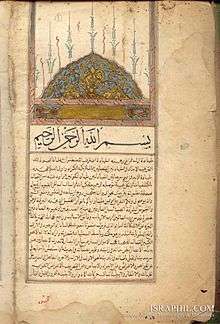
Abul Hasan ash-Shadhili (died 1258), the founder of the Shadhiliyya order, introduced dhikr jahri (the remembrance of God outloud, as opposed to the silent dhikr). He taught that his followers need not abstain from what Islam has not forbidden, but to be grateful for what God has bestowed upon them,[163] in contrast to the majority of Sufis, who preach to deny oneself and to destroy the ego-self (nafs) and its worldly desires. These two ways are sometimes referred to as "Order of Patience" (Tariqus-Sabr), as opposed to the "Order of Gratitude" (Tariqush-Shukr). Imam Shadhili also gave eighteen valuable hizbs (litanies) to his followers out of which the notable Hizb al-Bahr[164] is recited worldwide even today.
Abdul-Qadir Gilani
Abdul-Qadir Gilani (1077–1166) was a Persian Hanbali jurist and Sufi based in Baghdad. Qadiriyya was his patronym. Gilani spent his early life in Na'if, the town of his birth. There, he pursued the study of Hanbali law. Abu Saeed Mubarak Makhzoomi gave Gilani lessons in fiqh. He was given lessons about Hadith by Abu Bakr ibn Muzaffar. He was given lessons about Tafsir by Abu Muhammad Ja'far, a commentator. His Sufi spiritual instructor was Abu'l-Khair Hammad ibn Muslim al-Dabbas. After completing his education, Gilani left Baghdad. He spent twenty-five years as a reclusive wanderer in the desert regions of Iraq. In 1127, Gilani returned to Baghdad and began to preach to the public. He joined the teaching staff of the school belonging to his own teacher, Abu Saeed Mubarak Makhzoomi, and was popular with students. In the morning he taught hadith and tafsir, and in the afternoon he held discourse on the science of the heart and the virtues of the Qur'an.
Ahmad al-Tijani
Ahmad al-Tijani Abu al-ʿAbbâs Ahmad ibn Muhammad at-Tijânî or Ahmed Tijani (1735–1815), in Arabic سيدي أحمد التجاني (Sidi Ahmed Tijani), is the founder of the Tijaniyya Sufi order. He was born in a Berber family,[165][166][167] in Aïn Madhi, present-day Algeria and died in Fez, Morocco at the age of 80.
Bayazid Bastami
Bayazid Bastami is a very well recognized and influential Sufi personality. Bastami was born in 804 in Bastam. Bayazid is regarded for his devout commitment to the Sunnah and his dedication to fundamental Islamic principals and practices.
Ibn Arabi
Muhyiddin Muhammad b. 'Ali Ibn 'Arabi (or Ibn al-'Arabi) AH 561- AH 638 (July 28, 1165 – November 10, 1240) is considered to be one of the most important Sufi masters, although he never founded any order (tariqa). His writings, especially al-Futuhat al-Makkiyya and Fusus al-hikam, have been studied within all the Sufi orders as the clearest expression of tawhid (Divine Unity), though because of their recondite nature they were often only given to initiates. Later those who followed his teaching became known as the school of wahdat al-wujud (the Oneness of Being). He himself considered his writings to have been divinely inspired. As he expressed the Way to one of his close disciples, his legacy is that 'you should never ever abandon your servant-hood (ʿubudiyya), and that there may never be in your soul a longing for any existing thing'.[168]
Junayd of Baghdad
Junayd of Baghdad (830–910) was one of the great early Sufis. His order was Junaidia, which links to the golden chain of many Sufi orders. He laid the groundwork for sober mysticism in contrast to that of God-intoxicated Sufis like al-Hallaj, Bayazid Bastami and Abusaeid Abolkheir. During the trial of al-Hallaj, his former disciple, the Caliph of the time demanded his fatwa. In response, he issued this fatwa: "From the outward appearance he is to die and we judge according to the outward appearance and God knows better". He is referred to by Sufis as Sayyid-ut Taifa—i.e., the leader of the group. He lived and died in the city of Baghdad.
Moinuddin Chishti
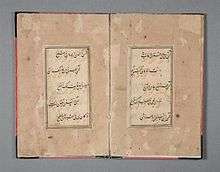
Moinuddin Chishti was born in 1141 and died in 1236. Also known as Gharīb Nawāz "Benefactor of the Poor", he is the most famous Sufi saint of the Chishti Order. Moinuddin Chishti introduced and established the order in the subcontinent. The initial spiritual chain or silsila of the Chishti order in India, comprising Moinuddin Chishti, Bakhtiyar Kaki, Baba Farid, Nizamuddin Auliya (each successive person being the disciple of the previous one), constitutes the great Sufi saints of Indian history. Moinuddin Chishtī turned towards India, reputedly after a dream in which Muhammad blessed him to do so. After a brief stay at Lahore, he reached Ajmer along with Sultan Shahāb-ud-Din Muhammad Ghori, and settled down there. In Ajmer, he attracted a substantial following, acquiring a great deal of respect amongst the residents of the city. Moinuddin Chishtī practiced the Sufi Sulh-e-Kul (peace to all) concept to promote understanding between Muslims and non-Muslims
Ahmed Ullah Maizbhandari
Ahmed Ullah Maizbhanderi was born on January 15, 1826, corresponding to Magh 1, 1233 of the Bengali calendar year. Sufi scholar Mohiuddin Ibn Arabi was said to have predicted the birth of Ahamed Ullah Maizbhanderi, 586 years earlier. The Tarika-e-Maizbhandari is an order established in the Bangladesh in the 19th century by the Gausul Azam Hazrat Shah Sufi Syed Ahmadullah Maizbhandari (1826 AD − 1906 AD), 27th descendent of Muhammad. The Maizbhandari Tariqa or Maizbhandari Sufi Order is based on seven methods to follow which make a man in perfect one with moral control and self purification. They are divided into two parts like Destruction of human instincts (Fana-E Salasa) and Death of Aptitude (Mout-E Arba).
Rabi'a al-'Adawiyya
Rabi'a al-'Adawiyya (died 801) was a flautist, mystic, and pilgrim who represents the distinctly countercultural elements of Sufism, especially with regards to the status and power of women. Prominent Sufi leader Hasan of Basra is said to have castigated himself before her superior merits and sincere virtues.[169] Rabi'a was born either a slave or a servant of very poor origin, released by her master when he awoke one night to see the light of sanctity shining above her head.[170] Rabi'a al-Adawiyya is known for her teachings and emphasis on the centrality of the love of God to a holy life.[171] Running down the streets of Basra, Iraq, she proclaimed:
"O God! If I worship You for fear of Hell, burn me in Hell, and if I worship You in hope of Paradise, exclude me from Paradise. But if I worship You for Your Own sake, grudge me not Your everlasting Beauty."— Rabi'a al-Adawiyya
She died in Jerusalem and is thought to have been buried in the Chapel of the Ascension.
Mansur Al-Hallaj
Mansur Al-Hallaj (died 922) is renowned for his claim, Ana-l-Haqq ("I am The Truth"). His refusal to recant this utterance, which was regarded as apostasy, led to a long trial. He was imprisoned for 11 years in a Baghdad prison, before being tortured and publicly dismembered on March 26, 922. He is still revered by Sufis for his willingness to embrace torture and death rather than recant. It is said that during his prayers, he would say "O Lord! You are the guide of those who are passing through the Valley of Bewilderment. If I am a heretic, enlarge my heresy".[172]
Sufi orders
The term Tariqa is used for a school or order of Sufism, or especially for the mystical teaching and spiritual practices of such an order with the aim of seeking ḥaqīqah (ultimate truth). A tariqa has a murshid (guide) who plays the role of leader or spiritual director. The members or followers of a tariqa are known as murīdīn (singular murīd), meaning "desirous", viz. "desiring the knowledge of knowing God and loving God".[173]
Bektashi
The Bektashi Order was founded in the 13th century by the Islamic saint Haji Bektash Veli, and greatly influenced during its fomulative period by the Hurufi Ali al-'Ala in the 15th century and reorganized by Balım Sultan in the 16th century.
Chishti
The Chishti Order (Persian: چشتیہ) was founded by (Khawaja) Abu Ishaq Shami ("the Syrian"; died 941) who brought Sufism to the town of Chisht, some 95 miles east of Herat in present-day Afghanistan. Before returning to the Levant, Shami initiated, trained and deputized the son of the local Emir (Khwaja) Abu Ahmad Abdal (died 966). Under the leadership of Abu Ahmad's descendants, the Chishtiyya as they are also known, flourished as a regional mystical order.
Kubrawiya
The Kubrawiya order is a Sufi order ("tariqa") named after its 13th-century founder Najmuddin Kubra. The Kubrawiya Sufi order was founded in the 13th century by Najmuddin Kubra in Bukhara in modern Uzbekistan.[174] The Mongols had captured Bukhara in 1221, they committed genocide and killed nearly the whole population. Sheikh Nadjm ed-Din Kubra was among those killed by the Mongols.
Mawlawiyya
The Mevlevi Order is better known in the West as the "whirling dervishes".
Muridiyya
Mouride is a large Islamic Sufi order most prominent in Senegal and The Gambia, with headquarters in the holy city of Touba, Senegal.[175]
Naqshbandi
The Naqshbandi order is one of the major Sufi orders of Islam. Formed in 1380, the order is considered by some to be a "sober" order known for its silent dhikr (remembrance of God) rather than the vocalized forms of dhikr common in other orders. The word "Naqshbandi" (نقشبندی) is Persian, taken from the name of the founder of the order, Baha-ud-Din Naqshband Bukhari. Some have said that the translation means "related to the image-maker", some also consider it to mean "Pattern Maker" rather than "image maker", and interpret "Naqshbandi" to mean "Reformer of Patterns", and others consider it to mean "Way of the Chain" or "Silsilat al-dhahab".
As mentioned below, the conception of Naqshbandi may require more elaboration and clarity as the explanation to this effect creating ambiguity and complicity with in it. The meanings of "Naqshbandi" is to follow the pattern of head of the former. In other words, "Naqshbandi" may be taken as "followup or like a flow chart" of practices exercised by the head of this school of thought.
Khālidīyyā
Khālidīyyā Sufi Order is a branch of the Naqshbandiyya Sufi Silsilat al-dhahab. It begins from the time of Khalid al-Baghdadi and continues until the time of Shaykh Ismail ash-Shirwani
Sülaymānīyyā
Sülaymānī Ṭarīqah is an offshoot of Naqshbandi Islamic Ṭarīqah founded by Sülaymān Hilmi Silistrevī in Turkey.[176] It was estimated that there were more than two million followers in Turkey in the early 1990s.[177] They are the most active branch in the private Hāfīz education in Turkey
Haqqānīyyā
Haqqānīyyā Ṭarīqah is an offshoot of Naqshbandi Islamic Ṭarīqah founded by Shaykh Nazim al-Qubrusi in order to spread the Sufi teachings and the Unity of belief in God that is present in all religions and spiritual paths as announced by its [www.sufilive.com].
Naqshbandia Mujaddidia Najmiya Riyaziya
The Naqshbandia Mujaddidia Najmiya Riyaziya [178] Golden Chain is a lineage spiritual masters of the Naqshbandi Islamic Ṭarīqah related to each other going back to the Prophet Muhammad. It was founded by Syed Riyaz Ahmad Naqshbandi in 1933 in Fatehpur, India.
Nimatullahi
The Ni'matullāhī order is the most widespread Sufi order of Persia today. It was founded by Shah Ni'matullah Wali (died 1367), established and transformed from his inheritance of the Ma'rufiyyah circle.[179] There are several suborders in existence today, the most known and influential in the West following the lineage of Dr. Javad Nurbakhsh who brought the order to the West following the 1979 Revolution in Iran.
Nurbakshi
The "Noorbakshia"[180] (Arabic: ش) also called Nubakshia is an Islamic sect and the Sufi order[181][182] and way that claims to trace its direct spiritual lineage and chain (silsilah) to the Islamic prophet Muhammad, through Ali, by way of Imam Ali Al-Ridha. This order became famous as Nurbakshi after Shah Syed Muhammad Nurbakhsh Qahistani who was attached with Kubrawiya order Sufi order ("tariqa").
Owaisi (Uwaiysi)
The Owaisi (Uwaiysi) order claim to be founded 1,400 years ago by Uwais al-Qarni from Yemen. Uways received the teachings of Islam inwardly through his heart and lived by the principles taught by him, although he had never physically met Muhammad. At times Muhammad would say of him, "I feel the breath of the Merciful, coming to me from Yemen." Shortly before Muhammad died, he directed Umar (second Caliph) and Ali (the fourth Caliph) to take his cloak to Uwais. "According to Ali Hujwiri, Farid ad-Din Attar of Nishapur and Sheikh Muhammad Ghader Bagheri, the first recipient of Muhammad's cloak was Uwais al-Qarni. The 'Original Cloak' as it is known is thought to have passed down the generations from the prophet Abraham to Muhammad, to Uwais al-Qarni, and so on."[183]
The Oveyssi order exists today in various forms and in different countries. According to Dr. Alan Godlas of the University of Georgia's Department of Religion, a Sufi Order or tariqa known as the Uwaysi is "very active", having been introduced in the West by the 20th century Sufi, Shah Maghsoud Angha. The Uwaysi Order is a Shi'i branch of the Kubrawiya.
In Pakistan several branches of owaisi silsila exist, notably the Silsila of Shams Ali Qalandar owaisi, qadri, noshahi with followers present all over the world, articles on tasawuf are given on order's official site.[184]
Godlas writes that there are two recent and distinct contemporary branches of the Uwaysi Order in the West:
Uwaiysi Tarighat, led by Shah Maghsoud Sadegh Angha's daughter, Seyyedeh Dr. Nahid Angha, and her husband Shah Nazar Seyed Ali Kianfar. Dr. Angha and Dr. Kianfar went on to found another the International Association of Sufism (IAS) which operates in California and organizes international Sufi symposia.
There is also an international non-profit organization, the MTO Shahmaghsoudi led by Hazrat Salaheddin Ali Nader Angha has over five-hundred thousand students with centers spanning five continents. With the use of modern technology and reach of the internet, weekly webcasts of the order's lecture and zekr sessions are broadcast live through the order's official website.[185]
Qadiri
The Qadiri Order is one of the oldest Sufi Orders. It derives its name from Abdul-Qadir Gilani (1077–1166), a native of the Iranian province of Gīlān. The order is one of the most widespread of the Sufi orders in the Islamic world, and can be found in Central Asia, Turkey, Balkans and much of East and West Africa. The Qadiriyyah have not developed any distinctive doctrines or teachings outside of mainstream Islam. They believe in the fundamental principles of Islam, but interpreted through mystical experience.
Sarwari Qadri
The Sarwari Qadri order[186] was founded by Sultan Bahu[187] which branched out of the Qadiriyyah order. Hence, it follows the same approach of the order but unlike most Sufi orders, it does not follow a specific dress code, seclusion, or other lengthy exercises. Its mainstream philosophy is related directly to the heart and contemplating on the name of Allah i.e. the word الله (Allah, God) as written on own heart.[188]
Maizbhandari
The Maizbhandari Tariqa or Maizbhandari Sufi Order is a liberated Sufism order established in the Bangladesh in the 19th century by the Gausul Azam Hazrat Shah Sufi Syed Ahmadullah Maizbhandari (1826 AD − 1906 AD), 27th descendent of Hazrat Ahmad Mustaba Muhammad Mustafa.
Senussi
Senussi is a religious-political Sufi order established by Muhammad ibn Ali as-Senussi. Muhammad ibn Ali as-Senussi founded this movement due to his criticism of the Egyptian ulema. Originally from Mecca, as-Senussi left due to pressure from Wahhabis to leave and settled in Cyrenaica where he was well received.[189] Idris bin Muhammad al-Mahdi as-Senussi was later recognized as Emir of Cyrenaica[190] and eventually became King of Libya. The monarchy was abolished by Muammar Gaddafi but, a third of Libyan still claim to be Senussi.
Shadiliyya
The Shadhili is a Sufi order founded by Abu-l-Hassan ash-Shadhili. Murids (followers) of the Shadhiliyya are often known as Shadhilis.[191][192]
Suhrawardiyya
The Suhrawardiyya order (Arabic: سهروردية) is a Sufi order founded by Abu al-Najib al-Suhrawardi (1097–1168). The order was formalized by his nephew, Shahab al-Din Abu Hafs Umar Suhrawardi.
Tijaniyya
The Tijaniyyah order attach a large importance to culture and education, and emphasize the individual adhesion of the disciple (murīd). [192]
Symbols associated with the Sufi Orders
-

The symbolic emblem of the Naqshbandi Sufi Order
-

Seal of the Chishti Order
-

Grave of Ma Yuanzhang, the Sufi Grand Master, in China
-

Allah's essence within a disciple's heart, associated with the Sarwari Qadri Order
-

Mirror calligraphy, symbolizing the Sufi Bektashi Order of the Dervish
-

Symbol of the Mevlevi Order
-
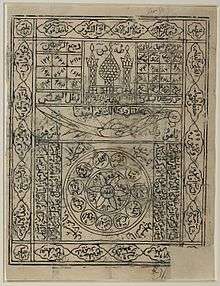
A symbol from the Mughal Empire: an amulet comprising magic squares, Quranic verses (including Al-Baqara 255 (Throne Verse) (2:255) running around the frame), and invocations to God, with a depiction of Zulfiqar at the center
Reception
Critique of Sufism's anti-materialistic aspects
Certain aspects of Sufi philosophy are controversial and often debated, chief among them is the anti-materialistic strain within its ethos. Gamal Marzouq, Professor of Islamic Philosophy in Ain-Shams University, in his paper titled "The effect of Christianity on the first emergence of Islamic Sufism", has highlighted the monastic and anti-materialist trends within Sufism, calling attention to their "abandoning materialism and living only for praying, something similar to monasticism".[193]
Conversely, the Quran calls out monasticism as a human invention not prescribed by God in the verse 57:27: "monasticism, which they innovated; We did not prescribe it for them...". Furthermore, there is much emphasis on physical laws of the universe within the Quran, urging believers to study and understand the "signs" of God in the physical world (e.g. verse 2:164), which precludes the possibility of avoiding or shunning the material world. Ibrahim B. Syed has called attention to the fact that the only definition of the word alim in the Quran, a word commonly understood to mean "religious leader" today, is actually referring to scientists, indicating the high importance afforded by the Quran to the material world and the act of engaging with it, so as to understand God's universe.[194] There are also the active aspects of the Quran's teachings which urge believers to seek to improve the human condition and work to establish the laws of God within human society (verse 22:41), a mission that does not fit well with the hermetic and monastic tendencies within Sufism.
Perception outside Islam

Sufi mysticism has long exercised a fascination upon the Western world, and especially its Orientalist scholars.[195] Figures like Rumi have become well known in the United States, where Sufism is perceived as a peaceful and apolitical form of Islam.[195][196] Orientalists have proposed a variety of diverse theories pertaining to the nature of Sufism, such as it being influenced by Neoplatonisma or as an Aryan historical reaction against "Semitic" cultural influence.[23] Hossein Nasr states that the preceding theories are false according to the point of view of Sufism.[23]
The Islamic Institute in Mannheim, Germany, which works towards the integration of Europe and Muslims, sees Sufism as particularly suited for interreligious dialogue and intercultural harmonisation in democratic and pluralist societies; it has described Sufism as a symbol of tolerance and humanism—nondogmatic, flexible and non-violent.[197] According to Philip Jenkins, a Professor at Baylor University, "the Sufis are much more than tactical allies for the West: they are, potentially, the greatest hope for pluralism and democracy within Muslim nations." Likewise, several governments and organisations have advocated the promotion of Sufism as a means of combating intolerant and violent strains of Islam.[198] For example, the Chinese and Russian[199] governments openly favor Sufism as the best means of protecting against Islamist subversion. The British government, especially following the 7 July 2005 London bombings, has favoured Sufi groups in its battle against Muslim extremist currents. The influential RAND Corporation, an American think-tank, issued a major report titled "Building Moderate Muslim Networks," which urged the US government to form links with and bolster[200] Muslim groups that opposed Islamist extremism. The report stressed the Sufi role as moderate traditionalists open to change, and thus as allies against violence.[201][202] News organisations such as the BBC, Economist and Boston Globe have also seen Sufism as a means to deal with violent Muslim extremists.[203]
Idries Shah states that Sufism is universal in nature, its roots predating the rise of Islam and Christianity.[204] Shah's views have however been rejected by modern scholars.[36] Such modern trends of neo-Sufis in Western countries allow non-Muslims to receive "instructions on following the Sufi path", not without opposition by Muslims who consider such instruction outside the sphere of Islam.[205][206]
Influence on Judaism
Both Judaism and Islam are monotheistic. However, there is evidence that Sufism did influence the development of some schools of Jewish philosophy and ethics. A great influence was exercised by Sufism upon the ethical writings of Jews in the Middle Ages. In the first writing of this kind, we see "Kitab al-Hidayah ila Fara'iḍ al-Ḳulub", Duties of the Heart, of Bahya ibn Paquda. This book was translated by Judah ibn Tibbon into Hebrew under the title "Ḥōḇōṯ Ha-lleḇāḇōṯ".[207]
The precepts prescribed by the Torah number 613 only; those dictated by the intellect are innumerable.
This was precisely the argument used by the Sufis against their adversaries, the Ulamas. The arrangement of the book seems to have been inspired by Sufism. Its ten sections correspond to the ten stages through which the Sufi had to pass in order to attain that true and passionate love of God which is the aim and goal of all ethical self-discipline. A considerable amount of Sufi ideas entered the Jewish mainstream through Bahya ibn Paquda's work, which remains one of the most popular ethical treatises in Judaism.
It is noteworthy that in the ethical writings of the Sufis Al-Kusajri and Al-Harawi there are sections which treat of the same subjects as those treated in the "Ḥovot ha-Lebabot" and which bear the same titles: e.g., "Bab al-Tawakkul"; "Bab al-Taubah"; "Bab al-Muḥasabah"; "Bab al-Tawaḍu'"; "Bab al-Zuhd". In the ninth gate, Baḥya directly quotes sayings of the Sufis, whom he calls Perushim. However, the author of the Ḥōḇōṯ Ha-lleḇāḇōṯ did not go so far as to approve of the asceticism of the Sufis, although he showed a marked predilection for their ethical principles.
The Jewish writer Abraham bar Ḥiyya teaches the asceticism of the Sufis. His distinction with regard to the observance of Jewish law by various classes of men is essentially a Sufic theory. According to it there are four principal degrees of human perfection or sanctity; namely:
- 1. of "Shari'ah", i.e., of strict obedience to all ritual laws of Islam, such as prayer, fasting, pilgrimage, almsgiving, ablution, etc., which is the lowest degree of worship, and is attainable by all
- 2. of Ṭariqah, which is accessible only to a higher class of men who, while strictly adhering to the outward or ceremonial injunctions of religion, rise to an inward perception of mental power and virtue necessary for the nearer approach to the Divinity
- 3. of "Ḥaḳikah", the degree attained by those who, through continuous contemplation and inward devotion, have risen to the true perception of the nature of the visible and invisible; who, in fact, have recognized the Godhead, and through this knowledge have succeeded in establishing an ecstatic relation to it; and
- 4. of the "Ma'arifah", in which state man communicates directly with the Deity.
Abraham ben Moses ben Maimon, the son of the Jewish philosopher Maimonides, believed that Sufi practices and doctrines continue the tradition of the Biblical prophets. See Sefer Hammaspiq, "Happerishuth", Chapter 11 ("Ha-mmaʿaḇāq") s.v. hithbonen efo be-masoreth mufla'a zo, citing the Talmudic explanation of Jeremiah 13:27 in Chagigah 5b; in Rabbi Yaakov Wincelberg's translation, "The Way of Serving God" (Feldheim), p. 429 and above, p. 427. Also see ibid., Chapter 10 ("Iqquḇim"), s.v. wa-halo yoḏeʾaʿ atta; in "The Way of Serving God", p. 371. There are other such references in Rabbi Abraham's writings, as well. He introduced into the Jewish prayer such practices as reciting God's names (dhikr).
Abraham Maimuni's principal work is originally composed in Judeo-Arabic and entitled "כתאב כפאיה אלעאבדין" Kitāb Kifāyah al-'Ābidīn ("A Comprehensive Guide for the Servants of God"). From the extant surviving portion it is conjectured that Maimuni's treatise was three times as long as his father's Guide for the Perplexed. In the book, Maimuni evidences a great appreciation for, and affinity to, Sufism. Followers of his path continued to foster a Jewish-Sufi form of pietism for at least a century, and he is rightly considered the founder of this pietistic school, which was centered in Egypt.
The followers of this path, which they called, interchangeably, Hasidism (not to be confused with the [later] Jewish Hasidic movement) or Sufism (Tasawwuf), practiced spiritual retreats, solitude, fasting and sleep deprivation. The Jewish Sufis maintained their own brotherhood, guided by a religious leader—like a Sufi sheikh.[208]
Abraham Maimuni's two sons, Obadyah and David, continued to lead this Jewish-Sufi brotherhood. Obadyah Maimonides wrote Al-Mawala Al Hawdiyya ("The Treatise of the Pool")—an ethico-mystical manual based on the typically Sufi comparison of the heart to a pool that must be cleansed before it can experience the Divine.
The Maimonidean legacy extended right through to the 15th century with the 5th generation of Maimonidean Sufis, David ben Joshua Maimonides, who wrote Al-Murshid ila al-Tafarrud (The Guide to Detachment), which includes numerous extracts of Suhrawardi's Kalimat at-Tasawwuf.
In popular culture
Films
- The Jewel of the Nile (1985), the eponymous Jewel is a Sufi holy man.
- In Hideous Kinky (1998), Julia (Kate Winslet) travels to Morocco to explore Sufism and a journey to self-discovery.
- In Monsieur Ibrahim (2003), Omar Sharif's character professes to be a Muslim in the Sufi tradition.
- Bab'Aziz (2005), a film by Tunisian director Nacer Khemir, draws heavily on the Sufi tradition, containing quotes from Sufi poets such as Rumi and depicting an ecstatic Sufi dance.
Music

Abida Parveen, a Pakistani Sufi singer is one of the foremost exponents of Sufi music, together with Nusrat Fateh Ali Khan are considered the finest Sufi vocalists of the modern era. Sanam Marvi another Pakistani singer has recently gained recognition for her Sufi vocal performances.
A. R. Rahman, the Oscar-winning Indian musician, has several compositions which draw inspiration from the Sufi genre; examples are the filmi qawwalis Khwaja Mere Khwaja in the film Jodhaa Akbar, Arziyan in the film Delhi 6 and Kun Faya Kun in the film Rockstar.
Bengali singer Lalan Fakir and Bangladesh's national poet Kazi Nazrul Islam scored several Sufi songs.
Junoon, a band from Pakistan, created the genre of Sufi rock by combining elements of modern hard rock and traditional folk music with Sufi poetry.
In 2005, Rabbi Shergill released a Sufi rock song called "Bulla Ki Jaana", which became a chart-topper in India and Pakistan.[209][210]
Madonna, on her 1994 record Bedtime Stories, sings a song called "Bedtime Story" that discusses achieving a high unconsciousness level. The video for the song shows an ecstatic Sufi ritual with many dervishes dancing, Arabic calligraphy and some other Sufi elements. In her 1998 song "Bittersweet", she recites Rumi's poem by the same name. In her 2001 Drowned World Tour, Madonna sang the song "Secret" showing rituals from many religions, including a Sufi dance.
American rock band mewithoutYou draw heavily on all of the Abrahamic religions in their music, with a heavy focus on Sufism. Their 2009 album It's All Crazy! It's All False! It's All a Dream! It's Alright is based on the teaching of Sufi mystic Bawa Muhaiyaddeen.
Singer/songwriter Loreena McKennitt's record The Mask and Mirror (1994) has a song called "The Mystic's Dream" that is influenced by Sufi music and poetry.
Tori Amos makes a reference to Sufis in her song "Cruel".
Mercan Dede is a Turkish composer who incorporates Sufism into his music and performances.
British folk singer Richard Thompson is a long-time Sufi.
Literature
.jpg)
The Persian poet Rumi, who was born in present-day Afghanistan, has become one of the most widely read poets in the United States, thanks largely to the interpretative translations published by Coleman Barks.[211] Elif Şafak's novel The Forty Rules of Love tells the story of Rumi becoming a disciple of the Persian dervish Shams Tabrizi. Furthermore, between 1910 and 1911 one of the first Sufi journals, called Hikmet, was published in Istanbul by Ahmad Hilmi of Filibe. Another Sufi-oriented journal was published in Egypt between 1931 and 1934. Al-Maʿrifa informed among others about Sufi moral and wisdom.
Modern and contemporary Sufi scholars
Gallery
-
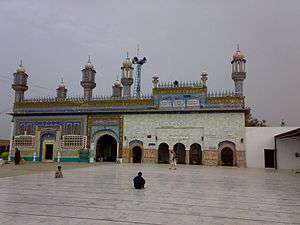
Shrine of Sultan Bahu of the Sarwari Qadiri
-

The Golden Chain of the Naqshbandi order
-

Tomb of Khwaja Ghulam Farid at Mithankot
-
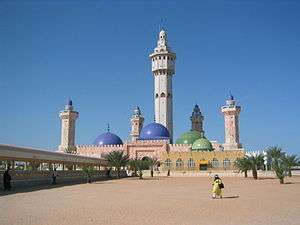
The Great Mosque of Touba, home of the Mouride Sufi order of Senegal
-

Haqqani Anjuman Faquiri Huzra Mubarak in Bagmari, Kolkata (State:WB, County:Ind), established in 1876 by Maulana Sufi Mufti Azangachhi Shaheb
-

Wali tomb, south of Karima, Sudan
-

The Rumi Museum in Konya, Turkey
-

An illustration of Ibrahima Fall, leader of the Mouride Order
-

The Mughal Emperor Jahangir preferring a Sufi shaikh to kings
-
-W.jpg)
Mazar e Soltani, Bidokht, Gonabad County. Shrine of four Qutbs (masters) of the Nimatullahi Sufi order
-
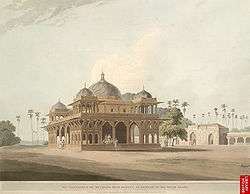
Mausoleum of Makhdoom Shah Daulat (d. 1608). Ibrahim Khan, the Mughal governor of Bihar, completed his mausoleum in 1616 during the reign of the Mughal Emperor Jahangir.
-

The shrine of Shah Arzani constructed during the reign of the Mughal Emperor Jahangir
-
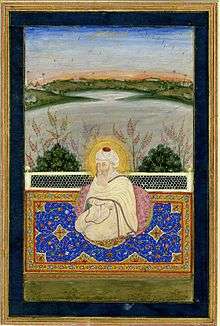
Pir Dastgir from the Mughal Empire
See also
- Etiquettes of Companionship - an English translation of Adab as-Suhbah by Imam ash-Sha'rani
- Dala'il al-Khayrat
- Index of Sufism-related articles
- Tawassul
- List of Sufi saints
- World Sufi forum
- Al-Maʿrifa (magazine)
References
- 1 2 3 Qamar-ul Huda (2003), Striving for Divine Union: Spiritual Exercises for Suhraward Sufis, RoutledgeCurzon, pp. 1–4
- ↑ Editors, The (2014-02-04). "tariqa | Islam". Britannica.com. Retrieved 29 May 2015.
- ↑ Glassé 2008, p. 499.
- ↑ Bin Jamil Zeno, Muhammad (1996). The Pillars of Islam & Iman. Darussalam. pp. 19–. ISBN 978-9960-897-12-7.
- ↑ Gamard 2004, p. 171.
- 1 2 3 4 5 6 7 Fitzpatrick & Walker 2014, p. 446.
- 1 2 Kabbani, Muhammad Hisham (2004). Classical Islam and the Naqshbandi Sufi Tradition. Islamic Supreme Council of America. p. 557. ISBN 1-930409-23-0.
- ↑ Schimmel, Annemarie (2014-11-25). "Sufism | Islam". Britannica.com. Retrieved 2015-05-29.
- ↑ A Prayer for Spiritual Elevation and Protection (2007) by Muhyiddin Ibn 'Arabi, Suha Taji-Farouki
- 1 2 G. R Hawting (2002). The First Dynasty of Islam: The Umayyad Caliphate AD 661-750. Taylor & Francis. ISBN 978-0-203-13700-0.
- ↑ Sells 1996, p. 1.
- ↑ Chittick 2007, p. 22.
- 1 2 Chittick (2008), p.6
- ↑ Alan Godlas, University of Georgia, Sufism's Many Paths, 2000.
- ↑ Guénon 2001.
- ↑ Glassé 2008, p. 500.
- ↑ World Sufi Mission
- 1 2 3 4 Chittick 2007.
- ↑ Chittick (2008), p.3,4,11
- ↑ Ahmed Zarruq, Zaineb Istrabadi, Hamza Yusuf Hanson. The Principles of Sufism. Amal Press. 2008.
- ↑ Corrections of Popular Versions of Poems From Rumi's Divan
- ↑ Ibrahim Gamard, Rumi and Self-Discovery
- 1 2 3 Nasr, Seyyed Hossein Nasr (1993-01-01). An Introduction to Islamic Cosmological Doctrines. ISBN 9780791415153. Retrieved 17 January 2015.
- ↑ The Naqshbandi Sufi Tradition Guidebook of Daily Practices and Devotions, p. 83, Muhammad Hisham Kabbani, Shaykh Muhammad Hisham Kabbani, 2004
- ↑ "Sufism in Islam". Mac.abc.se. Archived from the original on April 17, 2012. Retrieved 13 August 2012.
- ↑ The Bloomsbury Companion to Islamic Studies by Clinton Bennett, p 328
- ↑ "Origin of sufism – Qadiri". Sufi Way. 2003. Retrieved 13 August 2012.
- 1 2 Rashid Ahmad Jullundhry, Qur'anic Exegesis in Classical Literature, pg. 56. New Westminster: The Other Press, 2010. ISBN 9789675062551
- 1 2 "Khalifa Ali bin Abu Talib - Ali, The Father of Sufism - Alim.org". Retrieved 27 September 2014.
- ↑ Taking Initiation (Bay`ah), Naqshbandi Sufi Way
- ↑ Muhammad Hisham Kabbani, Classical Islam and the Naqshbandi Sufi tradition, Islamic Supreme Council of America, p. 644
- ↑ Shaykh Tariq Knecht, Journal of a Sufi Odyssey, Tauba Press
- ↑ IslamOnline.net Archived July 24, 2009, at the Wayback Machine.
- ↑ Massignon, Louis. Essai sur les origines du lexique technique de la mystique musulmane. Paris: Vrin, 1954. p. 104.
- ↑ Imam Birgivi, The Path of Muhammad, WorldWisdom, ISBN 0-941532-68-2
- 1 2 Encyclopædia Britannica, Retrieved on August 1st, 2016
- ↑ Nasr, Hossein (1993). An Introduction to Islamic Cosmological Doctrines. SUNY Press. ISBN 978-0-7914-1515-3.
- ↑ Ridgeon, Lloyd (2010). Morals and Mysticism in Persian Sufism: A History of Sufi-Futuwwat in Iran. Routledge. ISBN 978-1-136-97058-0., p. 32
- ↑ Ibn Khallikan's Biographical Dictionary, translated by William McGuckin de Slane. Paris: Oriental Translation Fund of Great Britain and Ireland. Sold by Institut de France and Royal Library of Belgium. Vol. 3, p. 209.
- ↑ Ahmet T. Karamustafa, Sufism: The Formative Period, pg. 58. Berkeley: University of California Press, 2007.
- ↑ J. Spencer Trimingham, The Sufi Orders in Islam, Oxford University Press, ISBN 978-0-19-512058-5.
- ↑ Daftary |Farhad |2013 |A History of Shi'i Islam |New York NY |I.B. Tauris and Co ltd. |page 28 |ISBN 9780300035315 |4/8/2015
- 1 2 The Jamaat Tableegh and the Deobandis by Sajid Abdul Kayum, Chapter 1: Overview and Background.
- ↑ Trimingham (1998), p. 1
- ↑ The most recent version of the Risâla is the translation of Alexander Knysh, Al-Qushayri's Epistle on Sufism: Al-risala Al-qushayriyya Fi 'ilm Al-tasawwuf (ISBN 978-1859641866). Earlier translations include a partial version by Rabia Terri Harris (Sufi Book of Spiritual Ascent) and complete versions by Harris, and Barbara R. Von Schlegell.
- ↑ "Home". Fons Vitae. Retrieved 29 May 2015.
- ↑ The Alchemy of Happiness at archive.org
- ↑ For the pre-modern era, see Vincent J. Cornell, Realm of the Saint: Power and Authority in Moroccan Sufism, ISBN 978-0-292-71209-6; and for the colonial era, Knut Vikyr, Sufi and Scholar on the Desert Edge: Muhammad B. Oali Al-Sanusi and His Brotherhood, ISBN 978-0-8101-1226-1.
- ↑ Leonard Lewisohn, The Legacy of Medieval Persian Sufism, Khaniqahi-Nimatullahi Publications, 1992.
- ↑ Seyyed Hossein Nasr, Islam: Religion, History, and Civilization, HarperSanFrancisco, 2003. (Ch. 1)
- ↑ Dina Le Gall, A Culture of Sufism: Naqshbandis in the Ottoman World, 1450–1700, ISBN 978-0-7914-6245-4.
- ↑ Arthur F. Buehler, Sufi Heirs of the Prophet: The Indian Naqshbandiyya and the Rise of the Mediating Sufi Shaykh, ISBN 978-1-57003-783-2.
- ↑ Victor Danner, The Islamic Tradition: An introduction. Amity House. February 1988.
- ↑ Masatoshi Kisaichi, "The Burhami order and Islamic resurgence in modern Egypt." Popular Movements and Democratization in the Islamic World, pg. 57. Part of the New Horizons in Islamic Studies series. Ed. Masatoshi Kisaichi. London: Routledge, 2006. ISBN 9781134150618
- ↑ Babou 2007, p. 184–6.
- ↑ Mbacké & Hunwick 2005.
- ↑ Chodkiewicz 1995, p. introduction.
- ↑ "Sufism – Oxford Islamic Studies Online". oxfordislamicstudies.com. Retrieved 26 August 2015.
- ↑ "Sufism, Sufis, and Sufi Orders: Sufism's Many Paths". uga.edu. Retrieved 26 August 2015.
- ↑ Abul Hasan ash-Shadhili (1993). The School of the Shadhdhuliyyah. Islamic Texts Society. ISBN 978-0-946621-57-6.
- ↑ Muhammad Emin Er, Laws of the Heart: A Practical Introduction to the Sufi Path, Shifâ Publishers, 2008, ISBN 978-0-9815196-1-6
- ↑ Abdullah Nur ad-Din Durkee, The School of the Shadhdhuliyyah, Volume One: Orisons; see also Shaykh Muhammad Hisham Kabbani, Classical Islam and the Naqshbandi Sufi Tradition, ISBN 978-1-930409-23-1, which reproduces the spiritual lineage (silsila) of a living Sufi master.
- 1 2 Momen, Moojan (1985). An Introduction to Shiʻi Islam: The History and Doctrines of Twelver Shiʻism. Yale University Press. ISBN 978-0-300-03531-5., page 209
- ↑ Mohammad Najib-ur-Rehman Madzillah-ul-Aqdus (2015). Sultan Bahoo: The Life and Teachings. Sultan ul Faqr Publications. ISBN 978-969-9795-18-3.
- ↑ See Muhammad Emin Er, Laws of the Heart: A Practical Introduction to the Sufi Path, Shifâ Publishers, 2008, ISBN 978-0-9815196-1-6, for a detailed description of the practices and preconditions of this sort of spiritual retreat.
- ↑ See examples provided by Muzaffar Ozak in Irshad: Wisdom of a Sufi Master, addressed to a general audience rather than specifically to his own students.
- ↑ Shaykh Muhammad Hisham Kabbani, Classical Islam and the Naqshbandi Sufi Tradition, ISBN 978-1-930409-23-1
- ↑ Carl W. Ernst (2010), p. 125
- 1 2 Carl W. Ernst, The Cambridge Companion to Muhammad, Muḥammad as the Pole of Existence, Cambridge University Press, p. 130
- ↑ Gholamreza Aavani, Glorification of the Prophet Muhammad in the Poems of Sa'adi, p. 4
- ↑ Gamard 2004, p. 169.
- ↑ Ibn Arabi, The Seals of Wisdom (Fusus al-Hikam), Aisha Bewley
- ↑ Fariduddin Attar, Ilahi-nama – The Book of God, John Andrew Boyle (translator),
Thou knowest that none of the poets have sung such praise save only I.
- ↑ Fariduddin Attar, Ilahi-nama – The Book of God, John Andrew Boyle (translator)
- ↑ The Signs of a Sincere Lover (PDF), p. 91
- 1 2 Suzanne Pinckney Stetkevych, The Mantle Odes: Arabic Praise Poems to the Prophet Muhammad, Indiana University Press
- ↑ Muhammad Emin Er, The Soul of Islam: Essential Doctrines and Beliefs, Shifâ Publishers, 2008, ISBN 978-0-9815196-0-9.
- ↑ Schimmel 2013, p. 99.
- ↑ (source: [pp. 778–795 of The Reliance of the Traveller, by Shaykh Nuh Ha Meem Keller])
- ↑ The Amman Message Summary. Retrieved on Feb 2, 2010.
- ↑ Universal Sufism, by Johan Witteveen; see also the commentary by Ken Shaw
- ↑ Elwell-Sutton, L. P. (May 1975). "Sufism & Pseudo-Sufism". Encounter XLIV (5): 16.
- ↑ "Neo-Sufism: The Case of Idries Shah by James Moore". gurdjieff-legacy.org. Retrieved 26 August 2015.
- 1 2 Muhammad Emin Er, Laws of the Heart: A Practical Introduction to the Sufi Order, Shifâ Publishers, 2008, ISBN 978-0-9815196-1-6
- ↑ For a systematic description of the diseases of the heart that are to be overcome in order for this perspective to take root, see Hamza Yusuf, Purification of the Heart: Signs, Symptoms and Cures of the Spiritual Diseases of the Heart, ISBN 978-1-929694-15-0.
- ↑ Concerning this, and for an excellent discussion of the concept of attraction (jadhba), see especially the Introduction to Abdullah Nur ad-Din Durkee, The School of the Shadhdhuliyyah, Volume One: Orisons, ISBN 977-00-1830-9.
- ↑ Muhammad Emin Er, al-Wasilat al-Fasila, unpublished MS.
- ↑ Realities of The Heart Lataif
- ↑ Schimmel 2013.
- ↑ See especially Robert Frager, Heart, Self & Soul: The Sufi Psychology of Growth, Balance, and Harmony, ISBN 978-0-8356-0778-0.
- ↑ Hakim Moinuddin Chisti, The Book of Sufi Healing, ISBN 978-0-89281-043-7
- ↑ For an introduction to the normative creed of Islam as espoused by the consensus of scholars, see Hamza Yusuf, The Creed of Imam al-Tahawi, ISBN 978-0-9702843-9-6, and Ahmad Ibn Muhammad Maghnisawi, Imam Abu Hanifa's Al-Fiqh Al-Akbar Explained, ISBN 978-1-933764-03-0.
- ↑ The meaning of certainty in this context is emphasized in Muhammad Emin Er, The Soul of Islam: Essential Doctrines and Beliefs, Shifâ Publishers, 2008, ISBN 978-0-9815196-0-9.
- ↑ See in particular the introduction by T. J. Winter to Abu Hamid Muhammad al-Ghazali, Al-Ghazali on Disciplining the Soul and on Breaking the Two Desires: Books XXII and XXIII of the Revival of the Religious Sciences, ISBN 978-0-946621-43-9.
- ↑ Akbar Ahmed, Diiscovering Islam, Making sense of Muslim History and Society, ISBN 0-415-28525-9(Pbk)
- ↑ Abdullah Jawadi Amuli, "Dhikr and the Wisdom Behind It"
- ↑ Hakim Moinuddin Chisti The Book of Sufi Healing, ISBN 978-0-89281-043-7
- ↑ "The Naqshbandi Way of Dhikr". web.archive.org. Retrieved 26 August 2015.
- ↑ Touma 1996, p.162
- ↑ What is Remembrance and what is Contemplation?
- ↑ "Muraqaba".
- ↑ Muhammad Emin Er, Laws of the Heart: A Practical Introduction to the Sufi Path, ISBN 978-0-9815196-1-6, p. 77.
- ↑ "The Sema of the Mevlevi". Mevlevi Order of America. Retrieved 2009-03-26.
- ↑ The Whirling Dervishes of Rumi
- 1 2 3 Salafi intolerance threatens Sufis |Baher Ibrahim |guardian.co.uk |10 May 2010
- ↑ Mir, Tariq. "Kashmir: From Sufi to Salafi". November 5, 2012. Pulitzer Center on Crisis Reporting. Retrieved 20 February 2013.
- 1 2 "Salafi Violence against Sufis". Islamopedia Online. Retrieved 24 February 2013.
- ↑ Momen, Moojan (1985). An Introduction to Shiʻi Islam: The History and Doctrines of Twelver Shiʻism. Yale University Press. ISBN 978-0-300-03531-5., pages 115–116
- ↑ Yadav, Rama Sankar (2007). Global Encyclopaedia of Education (4 Vols. Set). Global Vision Publishing House. p. 406. ISBN 9788182202276.
- ↑ Dalrymple, William (5 November 2005). "What goes round...". The Guardian. London.
- ↑ Introduction to Shi'i Islam, Momen, Moojan, Yale University Press, 1985 p.14-16
- 1 2 "Salafi destruction of shrines and public property unacceptable". Ikhwanweb. 3 April 2011. Retrieved 24 February 2013.
- 1 2 3 "Sunni Ittehad Council: Sunni Barelvi activism against Deobandi-Wahhabi terrorism in Pakistan – by Aarish U. Khan". lubpak.com. Retrieved May 18, 2016.
- ↑ Rana, Amir. "Where sufism stands". 1 August 2010. Express Tribune Blogs. Retrieved 4 March 2013.
- ↑ John R. Schmidt states, "although most Deobandis are no more prone to violence than their Christian fundamentalist counterparts in the West, every jihadist group based in Pakistan save one is Deobandi, as are the Afghan Taliban". The Unraveling: Pakistan in the Age of Jihad |John R. Schmidt |2011
- ↑ Behuria, Ashok K. (27 February 2008). "Sects Within Sect: The Case of Deobandi–Barelvi Encounter in Pakistan". Strategic Analysis. Taylor & Francis. 32 (1): 57–80. doi:10.1080/09700160801886330.
- ↑ Chakrabarty, Rakhi (Dec 4, 2011). "Sufis strike back". The Times of India. Retrieved 5 March 2013.
- ↑ Researcher Amir Rana (a researcher and editor quarterly research journal Conflict and Peace Studies. What is young Pakistan thinking?) claims than Deobandi themselves are often Sufi, as "Naqshbandi, the major Sufi cult in Pakistan, is mainly comprised of the Deobandis" (source: Rana, Amir. "Where sufism stands". 1 August 2010. Express Tribune Blogs. Retrieved 4 March 2013.). Maulana Qasim Nomani, the Rector of Deobandi seminary Darul Uloom Deoband has denied either that his school is anti-sufi or promotes militancy, stating Deoband scholars like Ashraf Ali Thanwi, and others were Sufi saints as well and they had their Khanqahs (Sufi hospice).
Who said we are against Sufism? We very much follow the Sufi traditions and all of our elders were Sufi practitioners of Sufi tradition (source: Ali, Md. "Deoband hits back, rejects "baseless" charge of radicalizing Muslim youth". 19 October 2011. TwoCircles.net. Retrieved 4 March 2013.)
According to the Jamestown Foundation, Deobandi have also been victims of sectarian strife.Scores of Deobandi leaders and members of Ahle Sunnat wal Jamat (ASWJ, formerly the banned Sipah-e-Sahaba Pakistan) have been assassinated in Karachi in recent years. Police sources say that the Sunni Tehrik, a Barelvi organization, is behind most of these assassinations. (source: Jamal, Arif. [http://www.jamestown.org/single/?no_cache=1&tx_ttnews[tt_news]=39288 "Karachi's Deadly Political and Sectarian Warfare Threatens the Stability of Pakistan's Commercial Capital"]. Terrorism Monitor April 20, 2012. Jamestown Foundation. Retrieved 4 March 2013.)
- ↑ Timeline: Persecution of religious minorities |DAWN.COM |4 November 2012
- ↑ "Pakistani Shiite massacre: Pakistan – Bari Imam shrine". May 27, 2005. Retrieved 5 March 2013.
- ↑ Azeem, Munawer (14 August 2011). "Two involved in Bari Imam suicide attack arrested". Dawn. Retrieved 4 March 2013.
- ↑ Raja, Mudassir (31 July 2011). "Bari Imam Shrine attack 2005: Police await suspects on judicial remand in another case". Express Tribune. Retrieved 24 February 2013.
- ↑ Bari Imam blast: Masterminds belong to LJ linked group By Shahzad Malik |14 June 2005
- ↑ Three LJ activists indicted in Nishtar Park blast case, Dawn (newspaper), 2 September 2009
- ↑ Tanoli, Ishaq (5 February 2012). "Six years on, Nishtar Park carnage trial remains inconclusive". Dawn. Retrieved 5 March 2013.
- 1 2 3 4 5 6 7 8 9 [http://www.jamestown.org/single/?no_cache=1&tx_ttnews[tt_news]=37826 "single | The Jamestown Foundation"]. Jamestown.org. Retrieved 29 May 2015.
- ↑ PESHAWAR: Another faith healer shot dead in Peshawar |By Ali Hazrat Bacha |dawn.com |18 February 2009
- ↑ Faith Healing and Skepticism in Pakistan: Challenges and Instability |Ryan Shaffer |csicop.org |Volume 36.6, November/December 2012
- ↑ Rodriguez, Alex (29 March 2012). "In Pakistan, faith healers have no shortage of believers". Los Angeles Times.
- ↑ Terrorism Monitor Brief, March 19, 2009
- ↑ And now Sunni vs Sunni Riaz ul Hassan |circa July 2010
- ↑ Al-Alawi, Irfan. "Urbanised Islam behind Pakistan's Sufi shrine bombings". 15 March 2011. Lapidomedia. Retrieved 26 February 2013.
- ↑ "Sarfraz Naeemi". lubpak.com. Retrieved May 18, 2016.
- ↑ Express Tribune, June 22, 2010
- ↑ Haque, Jahanzaib (October 7, 2010). "Twin suicide attacks at Abdullah Shah Ghazi shrine". Express Tribune. Retrieved 5 March 2013.
- ↑ "Blast at Baba Farid's shrine kills six". Express Tribune. October 26, 2010. Retrieved 5 March 2013.
- ↑ "Extremist Deobandis' attack on Ghazi Baba shrine in Peshawar". lubpak.com. 14 December 2010. Retrieved May 18, 2016.
- ↑ Masood, Salman; Gillani, Waqar (April 3, 2011). "Blast at Pakistan Shrine Kills Dozens". New York Times.
- ↑ "Three killed in Peshawar shrine blast". The News. 22 June 2012. Retrieved 5 March 2013.
- ↑ "Attack on Shah Noorani shrine in Pakistan kills dozens". Al Jazeera. 12 November 2016. Retrieved 5 March 2013.
- 1 2 Rana, Amir. "Kashmir: Sufi and Wahabbi Islam in Conflict". Pulitzer Center. Retrieved 24 February 2013.
- ↑ Ahmad, Mukhtar (June 25, 2012). "Fire destroys historic shrine, triggering anger in Kashmir". CNN. Retrieved 7 March 2013.
- ↑ "Libya and Mali: Salafi Islamists destroying shrines courtesy of Saudi Arabia and Qatar". Modern Tokyo Times. 26 August 2012. Retrieved 24 February 2013.
- ↑ "Al Shabab of Somalia Destroy the Graves of Sufi Saints – YouTube". youtube.com. Retrieved 26 August 2015.
- ↑ "Sufism re-emerges in Somalia as al-Shabab's control wanes". BBC News. Retrieved 26 February 2013.
- ↑ Timbuktu's Destruction: Why Islamists Are Wrecking Mali's Cultural Heritage |By Ishaan Tharoor|time.com |July 02, 2012
- ↑ "Sufism and Salafism, Mali's deep religious divide". Theafricareport.com. 21 December 2012. Retrieved 24 February 2013.
- ↑ "Destroying the Shrines of Timbuktu: Some Arab Responses". Islamopedia Online. Retrieved 24 February 2013.
- ↑ "Timbuktu shrine destruction 'a war crime'". Telegraph. London. 2 July 2012. Retrieved 24 February 2013.
- ↑ Leila, Reem (23–29 July 2009). "Moulid ban The annual celebration of birth of Sayeda Zeinab has been banned amid concern over the spread of swine flu". Al Ahram. Retrieved 20 February 2013.
- ↑ "Libya S.O.S.: Democracy Arrives in Libya: Sufi religious sites attacked and destroyed by Salafis". Libyasos. 26 August 2012. Retrieved 24 February 2013.
- 1 2 Libya: Stop Attacks on Sufi Sites |hrw.org |31 August 2012
- ↑ Libya clashes break out over Sufi shrine attack |bbc.co.uk |7 September 2012
- ↑ "UNESCO urges end to attacks on Libyan Sufi mosques, graves". Retrieved 27 September 2014.
- ↑ Benoit-Lavelle, Mischa (30 January 2013). "Tunisian Salafis on the Rise". al-monitor. Retrieved 18 April 2013.
- ↑ "Sheikh Murdered Over Religious Split Say Analysts | Russia | RIA Novosti". En.rian.ru. 30 August 2012. Retrieved 24 February 2013.
- ↑ "Sufi scholar, 5 others killed in Dagestan suicide bomb attack". Retrieved 27 September 2014.
- ↑ "single – The Jamestown Foundation". Retrieved 27 September 2014.
- ↑ Bos, Matthijs van den (2002). Mystic Regimes: Sufism and the State in Iran, from the Late Qajar Era to the Islamic Republic. Brill. ISBN 978-90-04-12815-6.
- 1 2 3 Esfandiari, Golnaz. "Wednesday, February 27, 2013 Features Sufism Under Attack In Iran". February 27, 2013. rferl.org. Retrieved 27 February 2013.
- 1 2 United States Commission on International Religious Freedom (May 2009). "Annual Report of the United States Commission on International Religious Freedom: Iran" (PDF). USG. Retrieved 25 December 2010.
- ↑ Schwartz, Stephen (30 April 2013). "Iran Continues Crackdown on Sufis". 04/30/2013. Huffington Post. Retrieved 6 May 2014.
- ↑ "Thareeqush Shukr". Shazuli.com. Retrieved 13 August 2012.
- ↑ "Deen islam -Hizb ul Bahr – Litany of the Sea". Retrieved 27 September 2014.
- ↑ Jestice, Phyllis G. (2004-12-15). Holy people of the world: a cross-cultural encyclopedia. ABC-CLIO. p. 858. ISBN 9781576073551.
- ↑ Willis, John Ralph (2012-10-12). Studies in West African Islamic History: Volume 1: The Cultivators of Islam, Volume 2: The Evolution of Islamic Institutions & Volume 3: The Growth of Arabic Literature. Routledge. p. 234. ISBN 9781136251603.
- ↑ Gibb, H. A. R. (1970-01-01). Mohammedanism. OUP USA. p. 116. ISBN 9780195002454.
- ↑ K. al-Wasa'il, quoted in The Unlimited Mercifier, Stephen Hirtenstein, p. 246
- ↑ Ahmed, Leila. Women and Gender in Islam. Yale University Press, 1992, p. 112.
- ↑ Ahmed, Leila. Women and Gender in Islam. Yale University Press, 1992, p. 133.
- ↑ Ahmed, Leila. Women and Gender in Islam. Yale University Press, 1992, p. 87.
- ↑ Memoirs of the Saints, p.108
- ↑ SILVA FILHO, Mário Alves da. A Mística Islâmica em Terræ Brasilis: o Sufismo e as Ordens Sufis em São Paulo. Dissertação (Mestrado em Ciências da Religião). São Paulo: PUC/SP, 2012.
- ↑ "Saif ed-Din Bokharzi & Bayan-Quli Khan Mausoleums". Retrieved 15 February 2015.
- ↑ "Mourides Celebrate 19 Years in North America" by Ayesha Attah. The African magazine. (n.d.) Retrieved 13 November 2007.
- ↑ Barry Rubin (2010), Guide to Islamist Movements, M.E. Sharpe. p410
- ↑ Banu Eligür (2010), The Mobilization of Political Islam in Turkey, Cambridge University Press
- ↑ http://www.ghuncha-e-marfat.org/stn.html
- ↑ Nasr, Seyyed Hossein (2007). The Garden of Truth. New York, NY: HarperCollins. p. 195. ISBN 978-0-06-162599-2.
- ↑ "Sufia Noorbakhshia". Sufia Noorbakhshia. Retrieved 15 February 2015.
- ↑ Aggarwal, Ravina (2004). Beyond Lines of Control: Performance and Politics on the Disputed Borders of Ladakh, India. Duke University Press. pp. 197–. ISBN 0-8223-3414-3.
- ↑ Kumar, Raj (2008). Encyclopaedia of Untouchables Ancient, Medieval and Modern. Gyan Publishing House. p. 345. ISBN 978-81-7835-664-8.
- ↑ Dr. Ronald Grisell (1983). Sufism. Ross Books. pp. 23. ISBN 978-0-89496-038-3
- ↑ "Hazrat Shams Ali Qalandar".
- ↑ "The Expansion of M.T.O. Shahmaghsoudi". MTO Shahmaghsoudi. Retrieved 26 December 2011."Through Hazrat Pir's deep commitment to his father's wish, the M.T.O. Shahmaghsoudi, School of Islamic Sufism, which he now leads, has developed into an international non-profit organization with over 500,000 students who attend centers located throughout five continents in America, Europe, Australia, Africa and Asia."
- ↑ Sarwari Qadiri Order. India: General Books LLC. ISBN 9781158473861.
- ↑ Sult̤ān Mohammad Najib-ur-Rehman. Sultan Bahoo: The Life and Teachings. Sultan-ul-Faqr Publications. ISBN 978-9-699-79518-3.
- ↑ Sult̤ān Bāhū (1998). Death Before Dying: The Sufi Poems of Sultan Bahu. University of California Press. ISBN 978-0-520-92046-0.=
- ↑ Metz, Helen Chapin. "The Sanusi Order". Libya: A Country Study. GPO for the Library of Congress. Retrieved 28 February 2011.
- ↑ A. Del Boca, "Gli Italiani in Libia – Tripoli Bel Suol d'Amore" Mondadori 1993, p. 415
- ↑ "Hazrat Sultan Bahu". yabahu.com. Retrieved 26 August 2015.
- 1 2 "Home – ZIKR". zikr.co.uk. Retrieved 26 August 2015.
- ↑ Karimah Suwaydan (2014-11-10). "25. Monks and Islamic Sufism | Arab West Report". Arabwestreport.info. Retrieved 29 May 2015.
- ↑ "Quran Inspires Modern Science". Irfi.org. 2001-11-19. Retrieved 29 May 2015.
- 1 2 Ron Geaves, Theodore Gabriel, Yvonne Haddad, Jane Idleman Smith: Islam and the West Post 9/11, Ashgate Publishing Ltd., p. 67
- ↑ Corbett, Rosemary R. (2016). Making Moderate Islam: Sufism, Service, and the "Ground Zero Mosque" Controversy. Stanford University Press.
- ↑ Jamal Malik, John R. Hinnells: Sufism in the West, Routledge, p. 25
- ↑ Philip Jenkins (January 25, 2009). "Mystical power". Globe Newspaper Company. Retrieved 26 June 2014.
- ↑ Tom Parfitt (23 November 2007). "The battle for the soul of Chechnya". Guardian News and Media Limited. Retrieved 26 June 2014.
- ↑ "Sufism: Of saints and sinners". The Economist Newspaper. Dec 18, 2008. Retrieved 26 June 2014.
- ↑ "MUSLIM NETWORKS AND MOVEMENTS IN WESTERN EUROPE". Pew Research Center. Government Promotion of Sufism. September 15, 2010. Retrieved 26 June 2014.
- ↑ Angel Rabasa, Cheryl Benard, Lowell H. Schwartz, Peter Sickle (2007). "Building Moderate Muslim Networks" (PDF). RAND Corporation. Retrieved 26 June 2014.
- ↑ ALI ETERAZ (June 10, 2009). "State-Sponsored Sufism". FP. Retrieved 26 June 2014.
- ↑ Munn, Richard C. (January–March 1969). "Reviewed work(s): The Sufis by Idries Shah". Journal of the American Oriental Society. American Oriental Society. 89 (1): 279–281. doi:10.2307/598339. JSTOR 598339.
- ↑ "Sufism, Sufis, and Sufi Orders: Sufism's Many Paths". Uga.edu. Retrieved 13 August 2012.
- ↑ Idries Shah, The Sufis, ISBN 0-385-07966-4
- ↑ A Sufi-Jewish Dialogue: Philosophy and Mysticism in Bahya ibn Paquda's Duties of the Heart, Diana Lobel
- ↑ Mireille Loubet. "Jewish pietism of the Sufi type". bcrfj.revues.org. Retrieved 26 August 2015.
- ↑ Zeeshan Jawed (4 June 2005). "Soundscape for the soul". The Telegraph. Calcutta. Retrieved 23 April 2008.
- ↑ Bageshree S. (26 March 2005). "Urban balladeer". The Hindu. Chennai, India. Retrieved 23 April 2008.
- ↑ Curiel, Jonathan (6 February 2005). "Islamic verses / The influence of Muslim literature in the United States has grown stronger since the Sept. 11 attacks". SFGate.
Bibliography
- Babou, Cheikh Anta (2007). "Sufism and Religious Brotherhoods in Senegal". The International Journal of African Historical Studies. 40 (1): 184.
- Chittick, William (2007). Sufism: A Beginner's Guide. Oneworld Publications. ISBN 978-1-78074-052-2.
- Chodkiewicz, Michel (1995). The Spiritual Writings of Amir ʿAbd al-Kader. SUNY Press. ISBN 978-0-7914-2446-9.
- Fitzpatrick, Coeli; Walker, Hani (2014). Muhammad in History, Theory, and Culture. ABC-Clio.
- Gamard, Ibrahim (2004). Rumi and Islam: Selections from His Stories, Poems, and Discourses, Annotated & Explained. SkyLight Paths Publishing. ISBN 978-1-59473-002-3.
- Glassé, Cyril (2008). The New Encyclopedia of Islam. Rowman & Littlefield Publishers. ISBN 978-0-7425-6296-7.
- Guénon, René (2001). Insights Into Islamic Esoterism and Taoism. Sophia Perennis. ISBN 978-0-900588-43-3.
- Mbacké, Khadim; Hunwick, John O. (2005). Sufism and Religious Brotherhoods in Senegal. Markus Wiener Publishers. ISBN 978-1-55876-342-5.
- Rahimi, Sadeq (September 2007). "Intimate Exteriority: Sufi Space as Sanctuary for Injured Subjectivities in Turkey". Journal of Religion and Health. Springer. 46 (3): 409–421. doi:10.1007/s10943-006-9073-2. JSTOR 27513026.
- Schimmel, Annemarie (2013). Mystical Dimension of Islam. Noura Books. ISBN 978-979-433-797-4.
- Schmidle, Nicholas (December 2008). "Pakistan's Sufis Preach Faith and Ecstasy". Smithsonian magazine.
- Sells, Michael (1996). Early Islamic Mysticism: Sufi, Qurʼan, Miraj, Poetic and Theological Writings. Paulist Press. ISBN 978-0-8091-3619-3.
- Chopra, R.M.,SUFISM (Origin, Growth, Eclipse, Resurgence), 2016, Anuradha Prakashan, New Delhi, ISBN 978-93-85083-52-5
External links
| Wikimedia Commons has media related to Sufism. |
| Wikiquote has quotations related to: Sufism |
| Wikibooks has a book on the topic of: Sufism |
- Sufism Oxford Islamic Studies Online
- Sufism at DMOZ
- Sufism, Sufis, and Sufi Orders – Sufism's Many Paths
- Extensive photo Essay on Sufism by a National Geographic photographer
- A Survey Of Decisive Arguments And Proof For Tasawwuf – Sufism in Islam
- Sufism and Love

